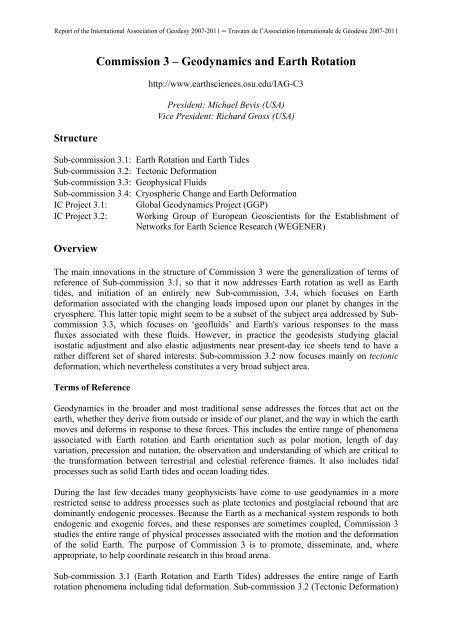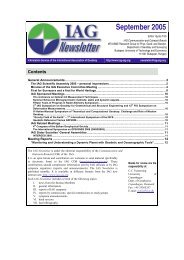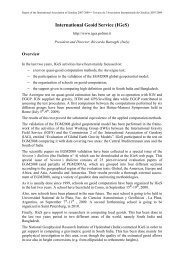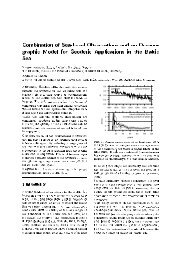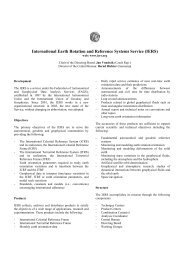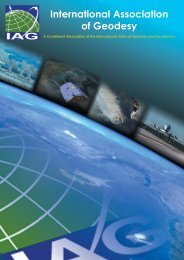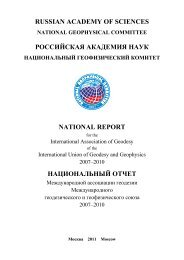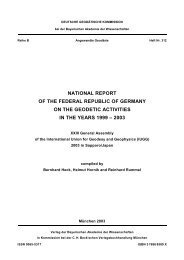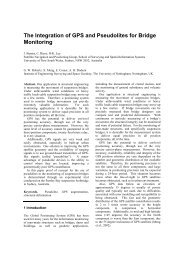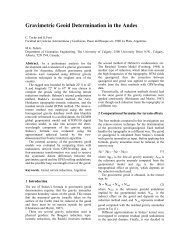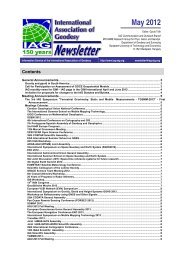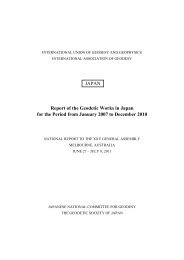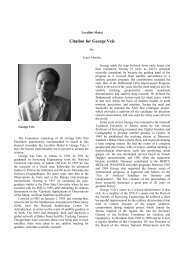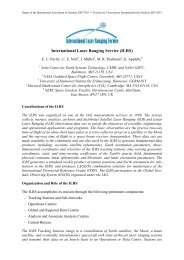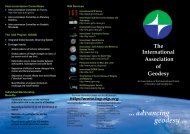Commission 3 â Geodynamics and Earth Rotation
Commission 3 â Geodynamics and Earth Rotation
Commission 3 â Geodynamics and Earth Rotation
- No tags were found...
You also want an ePaper? Increase the reach of your titles
YUMPU automatically turns print PDFs into web optimized ePapers that Google loves.
Report of the International Association of Geodesy 2007-2011 ─ Travaux de l’Association Internationale de Géodésie 2007-2011Structure<strong>Commission</strong> 3 – <strong>Geodynamics</strong> <strong>and</strong> <strong>Earth</strong> <strong>Rotation</strong>http://www.earthsciences.osu.edu/IAG-C3President: Michael Bevis (USA)Vice President: Richard Gross (USA)Sub-commission 3.1: <strong>Earth</strong> <strong>Rotation</strong> <strong>and</strong> <strong>Earth</strong> TidesSub-commission 3.2: Tectonic DeformationSub-commission 3.3: Geophysical FluidsSub-commission 3.4: Cryospheric Change <strong>and</strong> <strong>Earth</strong> DeformationIC Project 3.1:IC Project 3.2:OverviewGlobal <strong>Geodynamics</strong> Project (GGP)Working Group of European Geoscientists for the Establishment ofNetworks for <strong>Earth</strong> Science Research (WEGENER)The main innovations in the structure of <strong>Commission</strong> 3 were the generalization of terms ofreference of Sub-commission 3.1, so that it now addresses <strong>Earth</strong> rotation as well as <strong>Earth</strong>tides, <strong>and</strong> initiation of an entirely new Sub-commission, 3.4, which focuses on <strong>Earth</strong>deformation associated with the changing loads imposed upon our planet by changes in thecryosphere. This latter topic might seem to be a subset of the subject area addressed by Subcommission3.3, which focuses on ‘geofluids’ <strong>and</strong> <strong>Earth</strong>'s various responses to the massfluxes associated with these fluids. However, in practice the geodesists studying glacialisostatic adjustment <strong>and</strong> also elastic adjustments near present-day ice sheets tend to have arather different set of shared interests. Sub-commission 3.2 now focuses mainly on tectonicdeformation, which nevertheless constitutes a very broad subject area.Terms of Reference<strong>Geodynamics</strong> in the broader <strong>and</strong> most traditional sense addresses the forces that act on theearth, whether they derive from outside or inside of our planet, <strong>and</strong> the way in which the earthmoves <strong>and</strong> deforms in response to these forces. This includes the entire range of phenomenaassociated with <strong>Earth</strong> rotation <strong>and</strong> <strong>Earth</strong> orientation such as polar motion, length of dayvariation, precession <strong>and</strong> nutation, the observation <strong>and</strong> underst<strong>and</strong>ing of which are critical tothe transformation between terrestrial <strong>and</strong> celestial reference frames. It also includes tidalprocesses such as solid <strong>Earth</strong> tides <strong>and</strong> ocean loading tides.During the last few decades many geophysicists have come to use geodynamics in a morerestricted sense to address processes such as plate tectonics <strong>and</strong> postglacial rebound that aredominantly endogenic processes. Because the <strong>Earth</strong> as a mechanical system responds to bothendogenic <strong>and</strong> exogenic forces, <strong>and</strong> these responses are sometimes coupled, <strong>Commission</strong> 3studies the entire range of physical processes associated with the motion <strong>and</strong> the deformationof the solid <strong>Earth</strong>. The purpose of <strong>Commission</strong> 3 is to promote, disseminate, <strong>and</strong>, whereappropriate, to help coordinate research in this broad arena.Sub-commission 3.1 (<strong>Earth</strong> <strong>Rotation</strong> <strong>and</strong> <strong>Earth</strong> Tides) addresses the entire range of <strong>Earth</strong>rotation phenomena including tidal deformation. Sub-commission 3.2 (Tectonic Deformation)
Report of the International Association of Geodesy 2007-2011 ─ Travaux de l’Association Internationale de Géodésie 2007-2011addresses the entire range of tectonic phenomena including plate tectonics, intraplatedeformation, the earthquake deformation cycle, a-seismic phenomena such as episodic tremor<strong>and</strong> slip, <strong>and</strong> volcanic deformation. Sub-commission 3.3 (Geophysical Fluids) addresses thespace-time variation of atmospheric pressure, seafloor pressure <strong>and</strong> the surface loadsassociated with the hydrological cycle, <strong>and</strong> <strong>Earth</strong>'s (mainly elastic) responses to these massredistributions. Sub-commission 3.4 (Cryospheric Change <strong>and</strong> <strong>Earth</strong> Deformation) addressesthe <strong>Earth</strong>'s instantaneous <strong>and</strong> delayed responses to ice mass changes, including seasonal(cyclical) mass changes <strong>and</strong> progressive changes associated with climate change. This groupwill study postglacial rebound at all spatial scales, <strong>and</strong> also the elastic deformation takingplace in the near-field of existing ice sheets <strong>and</strong> glaciers.The areas addressed by the various Sub-commissions sometimes overlap. <strong>Commission</strong> 3 alsohas overlapping interests with other entities within the IAG, <strong>and</strong> with <strong>Commission</strong>s in otherAssociations such as the International Astronomical Union (IAU). The recent space missionGRACE has exp<strong>and</strong>ed our common interests with IAG <strong>Commission</strong> 2 (Gravity) sincetemporal changes in gravity are associated with both the drivers of <strong>Earth</strong> deformation (e.g.changing ice <strong>and</strong> loads) <strong>and</strong> with <strong>Earth</strong>'s response to these <strong>and</strong> other forcing.ObjectivesThe objectives of <strong>Commission</strong> 3 are to develop cooperation <strong>and</strong> collaboration in computation,in theory, <strong>and</strong> in observation of geodynamics <strong>and</strong> <strong>Earth</strong> rotation, <strong>and</strong> to ensure developmentof research in these areas by organizing meetings, symposia, <strong>and</strong> general assemblies, bycreating working groups on specific topics, <strong>and</strong> by encouraging exchange of ideas <strong>and</strong> data,comparisons of methods <strong>and</strong> results improving the accuracies, content, methods, theories, <strong>and</strong>underst<strong>and</strong>ing of geodynamics <strong>and</strong> <strong>Earth</strong> rotation. The <strong>Commission</strong> also serves thegeophysical community by helping the IAG to link scientists to the official organizationproviding the International Reference Systems/Frames <strong>and</strong> <strong>Earth</strong> orientation parameters(IERS <strong>and</strong> related bodies), <strong>and</strong> organizations providing all the other data on whichgeodynamics <strong>and</strong> <strong>Earth</strong> rotation studies can be performed.ActivitiesThe activities of <strong>Commission</strong> 3 during the last quadrennial are given in detail in the Subcommissionreports given below. Other major activities of <strong>Commission</strong> 3 during 2007–2011include:– Participation in IAG’s Global Geodetic Observing System (GGOS). Many of themembers of <strong>Commission</strong> 3 are members of the GGOS Steering Committee <strong>and</strong> the GGOSExecutive Committee.– Participation in special workshops <strong>and</strong> conference sessions related to geodynamics <strong>and</strong><strong>Earth</strong> rotation such as the Journées Systèmes de Références Spatio-temporels that wereheld in greater Paris (2007, 2010) <strong>and</strong> in Dresden (2008). Of special interest to<strong>Commission</strong> 3 during the past 4 years are the many great earthquakes <strong>and</strong> associatedtsunamis that have occurred recently <strong>and</strong> their impact on geodynamics <strong>and</strong> <strong>Earth</strong> rotation.Sessions at major conferences have been dedicated to these topics.– Strengthening the link between the Sub-commissions <strong>and</strong> Inter-commission Projects. ASymposium on “New Challenges in <strong>Earth</strong> Dynamics” was held in Jena, Germany inSeptember 2008 that included broad participation by all components of <strong>Commission</strong> 3.Another symposium planned to be held in Egypt in 2012 is also expected to involve all ofthe <strong>Commission</strong> 3 components.
Report of the International Association of Geodesy 2007-2011 ─ Travaux de l’Association Internationale de Géodésie 2007-2011– Strengthening the link between <strong>Commission</strong> 3 <strong>and</strong> the IAG Services. The IAG Servicesprovide the data <strong>and</strong> products needed to study geodynamics <strong>and</strong> <strong>Earth</strong> rotation <strong>and</strong> it isimportant that <strong>Commission</strong> 3 <strong>and</strong> the Services be closely linked to each other. This isbeing accomplished by <strong>Commission</strong> 3 members participating in GGOS <strong>and</strong> in the IERSGlobal Geophysical Fluids Center.– Strengthening the tie between IAG <strong>Commission</strong> 3 <strong>and</strong> IAU <strong>Commission</strong> 19 (<strong>Rotation</strong> ofthe <strong>Earth</strong>). Discussions have been held with the President of IAU <strong>Commission</strong> 19 aboutthe possibility of holding a joint workshop on <strong>Earth</strong> rotation like the joint GGOS/IAUworkshop on “Observing <strong>and</strong> Underst<strong>and</strong>ing <strong>Earth</strong> <strong>Rotation</strong>” that was held in Shanghai,China during October 25–28, 2010.
Report of the International Association of Geodesy 2007-2011 ─ Travaux de l’Association Internationale de Géodésie 2007-2011Sub-<strong>Commission</strong> 3.1: <strong>Earth</strong> <strong>Rotation</strong> <strong>and</strong> <strong>Earth</strong> TidesPresident: Gerhard Jentzsch (Germany)Vice-President: Spiros Pagiatakis (Toronto)During the IUGG General Assembly in Perugia, 2007, Gerhard Jentzsch was asked tocontinue his presidency. And again, Gerhard Jentzsch asked Spiros Patiatakis to act as Vice-President of this Sub-<strong>Commission</strong>. Since Olivier Francis did not want to continue as Secretarywe decided that we would pass on without nominating a secretary.1. Symposium on New Challenges in <strong>Earth</strong> Dynamics, including the 16 th InternationalSymposium on <strong>Earth</strong> Tides, together with the other two sub commissionsBecause of the re-organisation the old ‘<strong>Earth</strong> Tide <strong>Commission</strong>’ was renamed <strong>and</strong> the scopewas extended to ‘<strong>Earth</strong> <strong>Rotation</strong> <strong>and</strong> <strong>Earth</strong> Tides’. The new definition <strong>and</strong> the development ofthe terms of reference covered the first months after the IUGG 2007.A main task was the preparation of the 16th International Symposium on <strong>Earth</strong> Tides to beheld in Jena in September 2008 together with the other Sub-<strong>Commission</strong>s of <strong>Commission</strong> 3<strong>and</strong> including inter-commission projects <strong>and</strong> study groups. The symposium was a successfulevent: 116 colleagues from 24 countries took part. The motto of the symposium was “NewChallenges in <strong>Earth</strong> Dynamics”.During the symposium, the <strong>Earth</strong> Tide <strong>Commission</strong> Medal was awarded to two well knowncolleagues:Bernard Ducarme <strong>and</strong> Tadahiro SatoThe documents as well as the nominating essays written by Walter Zürn for Tadahiro Sato<strong>and</strong> David Crossley for Bernard Ducarme are published in volume 144 of the Bulletind’Information Marées Terrestres. This was the third <strong>and</strong> last time this medal was awarded:The name of the commission has changed, <strong>and</strong>, thus, the name of the medal has to be changedas well (see below).The proceedings were split up in two parts: The first part contains speeches, reports <strong>and</strong>organizational details as well as the resolutions <strong>and</strong> the more technical papers collected for theBulletin d’Information Marées Terrestres (BIM); the first volume no. 144 was alreadypublished in December 2008, no. 145 followed in Dec. 2009, <strong>and</strong> no. 146 was available inDec. 2010. The second part of the proceedings contains papers published by the Journal of<strong>Geodynamics</strong>: a special issue containing 40 papers was prepared by guest editors Jentzsch,Jahr, <strong>and</strong> Kroner. The special issue, Vol. 45, Nos. 3-5, appeared in Dec. 2009.The resolutions approved at the end of the symposium touch different topics:1. The <strong>Earth</strong> Tide <strong>Commission</strong> Medal should be renamed as Paul Melchior Medal toacknowledge first the fact that the <strong>Earth</strong> Tide <strong>Commission</strong> does not exist any more underthis name. More important are the tremendous activities Paul Melchior put into thedevelopment of tidal research, especially his activities world-wide, to name this medalafter him.2. The next symposium to be held in Egypt in 2012 (invited by the National ResearchInstitute for Astronomy <strong>and</strong> Geophysics) should also combine all sub-commissions <strong>and</strong>inter-commission committees.
Report of the International Association of Geodesy 2007-2011 ─ Travaux de l’Association Internationale de Géodésie 2007-20113. One scientific point concerns the estimation of ocean tide models which often give thetide height only. Since also the angular momentum of tidal currents is needed to modeltidal effects, in future beside tide heights also barotropic tidal currents should be takeninto account.4. Organisational points concern the Global <strong>Geodynamics</strong> Project (GGP): Its transitionfrom an Inter-<strong>Commission</strong> project to an IAG Service should be discussed to prepare aproposal to be decided during the next IUGG (2011). Second, the running of the GGPdata base should cover several tasks for the benefit of the community of users, likest<strong>and</strong>ardisation to 1-minute data, calibration history of the SGs, <strong>and</strong> providing corrected1-minute data as well as the results of the tidal analyses to all users.Following these resolutions, the family of Paul Melchior was asked to agree to name themedal after Paul Melchior – the answer was positive. Concerning the next symposium to beheld in Egypt, invited by the National Research Institute for Astronomy <strong>and</strong> Geophysics(NRIAG), the negotiations were carried on. Prof. Dr. Khaled Zahran is the responsiblescientist. The intention is to hold the meeting in Cairo, outside the period of hightemperatures.2. ICET <strong>and</strong> next meetingAnother task was the move of the International Center for <strong>Earth</strong> Tides to another place,because the Royal Observatory of Belgium did not agree to continue to host ICET afterBernard Ducarme’s retirement at the end of 2007. After discussions with several potentiallyinterested institutions, during the last meeting of Sub-<strong>Commission</strong> 3.1 in Perugia, 2007, it wasdecided to accept the offer of the University of French Polynesia, Tahiti, to host ICET; Jean-Pierre Barriot is the responsible scientist.From Oct. 03 to 11, 2010, Jentzsch visited the new ICET in Tahiti to see the progress <strong>and</strong> totalk to the local staff. In all, the impression is promising, but there is still a lot to do until theprevious st<strong>and</strong>ard is reached again. The problems concern the work with the data as well asthe Bulletin (BIM), which appears now electronically with only a few printed copies.In connection with ICET we also had to discuss the future of the GGP data base as an integralcomponent of the IAG GGOS program: There exists a cooperation agreement between ICET<strong>and</strong> GFZ – Potsdam to host <strong>and</strong> maintain this data base within the GFZ/ISDC. But after somechanges involved colleagues have some concerns about the future support. Therefore, duringthe last symposium Gerhard Jentzsch was asked to discuss the matter with the president ofGFZ or the management board. Up to now several letters were written, but without anyanswer. Also before the IAG in Buenos Aires in 2009 there was no official answer to bereported during the splinter meeting of Sub-<strong>Commission</strong> 3.1.On 30 th of June, 2011, the Sub-<strong>Commission</strong> 3.1 will have a splinter meeting during the IUGGGeneral Assembly in Melbourne. During this meeting a new president has to be elected;Jentzsch will not more be available due to retirement.
Report of the International Association of Geodesy 2007-2011 ─ Travaux de l’Association Internationale de Géodésie 2007-20113. Working groups of SC3.1The SC3.1 has three working groups which continued during the period 2005-2011:– <strong>Earth</strong> Tides in Geodetic Space Techniques, co-chaired by H. Schuh <strong>and</strong> Wu Bin,– Analysis of Environmental Data for the Interpretation of Gravity Measurements, chairedby C. Kroner,– Precise Tidal Prediction, chaired by Y. Tamura.4. Future workThe future work will have two main tasks:1. First, we will have to support the new International Center to help to develop its newfeature following modern needs <strong>and</strong> using the available digital <strong>and</strong> internet facilities.Here, we have to consider that Tahiti is quite far away <strong>and</strong> not so easy to reach likeBrussels was. Further, new ICET has to develop research goals <strong>and</strong>, thus, gainexperiences <strong>and</strong> to make them available to the community.2. The second task is the next symposium: It will be the first symposium in Africa, <strong>and</strong> asmall but quite active group in Cairo will be responsible (supported by the NationalResearch Institute for Astronomy <strong>and</strong> Geophysics). With this symposium in Egypt wehope to advertise for research in geodynamics <strong>and</strong> long-period crustal dynamics, also incountries not so much involved up to now.Further, we need a new president to be elected during the meeting in Melbourne, 2011.
Report of the International Association of Geodesy 2007-2011 ─ Travaux de l’Association Internationale de Géodésie 2007-2011Sub-<strong>Commission</strong> 3.2: Tectonic DeformationPresident: Markku Poutanen (Finl<strong>and</strong>)Members of the board:Markku Poutanen (Finl<strong>and</strong>), PresidentJeffrey Freymueller (USA), vice presidentJames Davis (USA), Cryospheric Change <strong>and</strong> <strong>Earth</strong> DeformationKosuke Heki (Japan), Asia-Pacific area coordinatorJanusz Sledzinski (Pol<strong>and</strong>), <strong>Geodynamics</strong> of the Central EuropeSusanna Zerbini (Italy), WEGENER <strong>and</strong> GEOOverviewThere are many geodetic signals that can be observed <strong>and</strong> are representative of thedeformation mechanisms of the <strong>Earth</strong>'s crust at different spatial <strong>and</strong> temporal scales. Thisinclude the entire range of tectonic phenomena including plate tectonics, intraplatedeformation, the earthquake deformation cycle, aseismic phenomena such as episodic tremor<strong>and</strong> slip, <strong>and</strong> volcanic deformation. The time scales range from seconds to years <strong>and</strong> frommillimetres to continental dimension for the spatial scales.Space geodetic measurements provide nowadays the means to observe deformation <strong>and</strong>movements of the <strong>Earth</strong>'s crust at global, regional <strong>and</strong> local scales. This is a considerablecontribution to global geodynamics by supplying primary constraints for modeling the planetas a whole, but also for underst<strong>and</strong>ing geophysical phenomena occurring at smaller scales.Gravimetry, absolute, relative <strong>and</strong> nowadays also spaceborn, is a powerful tool providinginformation to the global terrestrial gravity field <strong>and</strong> its temporal variations. Superconductinggravimeters allow a continuous acquisition of the gravity signal at a given site with aprecision of 10 -10 . This is important in order to be able to detect <strong>and</strong> model environmentalperturbing effects as well as the weak gravity signals associated with vertical crustalmovements of the order of mm/yr. These geodetic observations together with othergeophysical <strong>and</strong> geological sources of information provide the means to underst<strong>and</strong>ing thestructure, dynamics <strong>and</strong> evolution of the <strong>Earth</strong> system.One of the key issues nowadays is the definition <strong>and</strong> stability of global <strong>and</strong> regional referenceframes. Tectonic deformations in all time <strong>and</strong> spatial scales as well as mass transfer will affectreference frames. The work done in SC3.2 will deal in information essential to the referenceframes.Events 2008-2011<strong>Earth</strong> Tides SymposiumThe <strong>Commission</strong> 3 of the IAG together with sub-commissions on <strong>Earth</strong> Tides (3.1), CrustalDeformation (3.2), Geophysical Fluids (3.3) <strong>and</strong> the Global <strong>Geodynamics</strong> Project (GGP)organized for the first time a joint meeting in Jena, Germany, September 1-5, 2008. Itincluded the 16th International Symposium on <strong>Earth</strong> Tides. The assembly provided a uniqueopportunity to exchange new results <strong>and</strong> strategies to meet the current challenges of <strong>Earth</strong>’sdynamics from different viewpoints. Subcommission 3.2 was responsible of plans <strong>and</strong>
Report of the International Association of Geodesy 2007-2011 ─ Travaux de l’Association Internationale de Géodésie 2007-2011arrangements of one session, as well as arranging the review of papers in session submittedfor the proceedings.A special issue containing 40 papers was published in Journal of <strong>Geodynamics</strong> special issue,Vol. 45, Nos. 3-5, 2009. A non-reviewed publication containing speeches, reports <strong>and</strong> thetechnical papers appeared in the series of Bulletin d’Information Marées Terrestres 144, 145<strong>and</strong> 146 in 2008-2010.DynaQlim - GGOS workshopThe Global Geodetic Observing System (GGOS) of the International Association of Geodesy(IAG) <strong>and</strong> the International Lithosphere Program (ILP) Regional Co-ordination CommitteeDynaQlim organized a joint workshop "Underst<strong>and</strong>ing Glacial Isostatic Adjustment" inEspoo, Finl<strong>and</strong> June 23-26, 2009. Local Organisers were the ILP National Committee, <strong>and</strong>DynaQlim, IAG Subcommission 3.2. Tectonic deformations, Finnish Geodetic Institute, GeologicalSurvey of Finl<strong>and</strong>, <strong>and</strong> University of Helsinki. The objective of the workshop was toreview the current state of the science in modeling glacial isostatic adjustment, to review theuse of geodetic measurements to both constrain <strong>and</strong> to test GIA models, to identify obstaclesto improving GIA models, <strong>and</strong> to identify the improvements to the global geodetic observingsystem that are required to advance our underst<strong>and</strong>ing of glacial isostatic adjustment.The major outcome of the workshop was a report summarizing the current state of thescience, a description of future research directions, <strong>and</strong> a description of the future observationsthat are needed to improve our underst<strong>and</strong>ing of glacial isostatic adjustment. Thissummary was published in Gross, R., M. Poutanen (2009): Geodetic Observations of GlacialIsostatic Adjustment. EOS, Vol. 90, No. 41, p. 365. The proceedings will be published in thePhysics <strong>and</strong> Chemistry of the <strong>Earth</strong>, in 2011.Steering Committee meeting 2009A meeting of the steering committee was arranged during the IAG Assembly in Buenos Aires,Sept. 2, 2009. Present: Markku Poutanen, Jeff Freymueller, Kosuke Heki <strong>and</strong> JanuszSledzinski. Susanna Zerbini consulted.1. Short report by MP about last year activities.2. Janusz Sledzinski gave a report on Central European Initiative activity.3. Discussion on ways to activate the work of the SC.Based on the discussion in the SC meeting two tasks were initiated:a) Attempt to co-organize a session in the IUGG General Assembly in Melbourne 2011 <strong>and</strong>arranging a special issue in a peer reviewed journal. There are now two SC3.2 relatedsessions in the Melbourne GA where SC3.2 members are as co-organizers:J-G04: Structure <strong>and</strong> Deformation of Plate Interiors.– Organiser: IAG– Co-sponsor: IASPEI, IAVCEI– Lead Convenor: John Dawson– Co-convenors: Sierd Cloetingh, Kevin Furlong, Markku Poutanen
Report of the International Association of Geodesy 2007-2011 ─ Travaux de l’Association Internationale de Géodésie 2007-2011J-G06: Tectonic Geodesy <strong>and</strong> <strong>Earth</strong>quakes– Organiser: IAG– Co-Sponsors: IASPEI– Lead Convenors: David D. Jackson, Jeff Freymueller– Co-Convenors: Valentin Mihkailovb) Co-operation with IAG Working Group “Regional Dense Velocity Fields”, chaired byCarine Bruyninx. There has been some preliminary discussion with MP <strong>and</strong> CarineBruyninx about the idea, <strong>and</strong> it was agreed to continue discussion.Permanent working group <strong>Geodynamics</strong> of the Central EuropePermanent Working Group on ‘<strong>Geodynamics</strong> of the Central Europe’, (reported by JanuszSledzinski, Pol<strong>and</strong>) has continued studies on geotectonic regions of Central Europe. Till 2008the programme of activities was coincided <strong>and</strong> overlapped with actions performed by theSection C, Geodesy, of the WG Science <strong>and</strong> Technology of the Central European Initiative(CEI). In 2008 CEI has abolished. The formal membership list of the IAG WG includes 27scientists from 12 European countries. The activities of the WG concentrated on the followingsubjects:– European geodetic <strong>and</strong> geodynamic programmes:– CERGOP = Central Europe Regional <strong>Geodynamics</strong> Project;– CEGRN = (Central European GPS Reference Network) Consortium,– Local geodynamic projects– subgroups of the CERGOP Study Group CSG.5 Geotectonic Analysis of the Regionof Central Europe in the following regions:– Eastern Alps <strong>and</strong> the North <strong>and</strong> Eastern Adriatic Sea; Romania Plate; PannonianBasin; Plitvice Lakes, Croatia; Tatra Mountains; Northern Carpathians; BalkanPeninsula.– Cooperation of CEI Section C Geodesy <strong>and</strong> European Geosciences Union (EGU)Future plansA new president for SC3.2 will be elected during the GA in Melbourne.One should seek ways to activate the work of subcommission in the framework defined by the<strong>Commission</strong> 3. Establishing regional working groups similar to WG in Central Europe mayhelp in this. Close contacts with related groups outside IAG, like WEGENER (Working groupof European Geoscientists for the Establishment of Networks for <strong>Earth</strong> science Research) <strong>and</strong>DynaQlim (Upper Mantle Dynamics <strong>and</strong> Quaternary Climate in Cratonic Areas) will becontinued.
Report of the International Association of Geodesy 2007-2011 ─ Travaux de l’Association Internationale de Géodésie 2007-2011Sub-<strong>Commission</strong> 3.3: Geophysical FluidsPresident: Aleks<strong>and</strong>er Brzezinski (Pol<strong>and</strong>)Vice-President: Mike Thomas (Germany)Members: David Salstein (USA) - AtmosphereRui Ponte (USA) - OceansRichard D. Ray (USA) - TidesBenjamin F. Chao (Taiwan) - HydrologyRichard Peltier (Canada) - MantleTim van Hoolst (Belgium) - CoreErricos Pavlis (USA) - Gravity/GeocenterTonie van Dam (Luxembourg) - LoadingTerms of ReferenceCharterMass transport in the atmosphere-ocean-cryosphere-mantle-core system, or the “globalgeophysical fluids”, cause observable geodynamic effects on broad time scales. Althoughrelatively small, these global geodynamic effects have been measured by space geodetictechniques to increasing, unprecedented accuracy, opening up important new avenues ofresearch that will lead to a better underst<strong>and</strong>ing of global mass transport processes <strong>and</strong> of the<strong>Earth</strong>’s dynamic response. Angular momenta <strong>and</strong> the related torques, gravitational fieldcoefficients, <strong>and</strong> geocenter shift for all geophysical fluids are the relevant quantities. They arestudied theoretically <strong>and</strong> are observed using global-scale measurements <strong>and</strong>/or products fromstate-of-the-art models, some of which assimilate such measurements.ObjectivesThe objective of the Sub-<strong>Commission</strong> is to serve the scientific community by supportingresearch <strong>and</strong> data analysis in areas related to variations in <strong>Earth</strong> rotation, gravitational field<strong>and</strong> geocenter caused by mass transport in the geophysical fluids, which include theatmosphere, ocean, continental water, mantle, <strong>and</strong> core along with geophysical processesassociated with ocean tides <strong>and</strong> the hydrological cycle.– The Sub-<strong>Commission</strong> is aware that its objectives overlap with the objectives of the IAGGlobal Geodetic Observing System (GGOS) with its central theme “Global deformation<strong>and</strong> mass exchange processes in the <strong>Earth</strong> system” <strong>and</strong> the following areas of activities– deformation due to the mass transfer between solid <strong>Earth</strong>, atmosphere, <strong>and</strong> hydrosphereincluding ice;– quantification of angular momentum exchange <strong>and</strong> mass transfer.Program of ActivitiesSub-<strong>Commission</strong> 3.3 follows the program defined by <strong>Commission</strong> 3. In addition, SC 3.3interacts with the sister organizations <strong>and</strong> services, particularly with the Global GeophysicalFluids Center (GGFC) of the International <strong>Earth</strong> <strong>Rotation</strong> <strong>and</strong> Reference Frames Service(IERS) <strong>and</strong> its components: three operational Special Bureaus - for the Atmosphere SBA,Oceans SBO, <strong>and</strong> Hydrology SBH, Special Bureau for combination products <strong>and</strong> the non-
Report of the International Association of Geodesy 2007-2011 ─ Travaux de l’Association Internationale de Géodésie 2007-2011operational components. Due to the overlapping of the tasks, SC 3.3 should also have closecontacts to the GGOS activities.Report on Activities 2007-2011The Sub-<strong>Commission</strong> 3.3 participated, together with the Sub-<strong>Commission</strong>s 3.1 “<strong>Earth</strong><strong>Rotation</strong> <strong>and</strong> <strong>Earth</strong> Tides”, 3.2 “Crustal Deformation”, <strong>and</strong> the Inter-<strong>Commission</strong> Global<strong>Geodynamics</strong> Project (GGP), in organization of the <strong>Earth</strong> Tide Symposium 2008 “NewChallenges in <strong>Earth</strong>’s Dynamics” in Jena, Germany, 1-5 September 2008. This jointsymposium was an important event strengthening interactions between these 3 Sub-<strong>Commission</strong>s <strong>and</strong> the GGP. The Organizing Committee of ETS2008 decided to continue theidea of joint symposium with the next ETS, to be held in Egypt.Important exchanges of information at meetings during the period occurred at the IERSWorkshops, 2007 in Sevres, France, <strong>and</strong> 2009 in Warsaw, Pol<strong>and</strong>, at the conferences of theseries Journées Systèmes de Référence Spatio-Temporels, 2007 in Meudon, France, 2008 inDresden, Germany, <strong>and</strong> 2010 in Paris, France, at the American Geophysical Union meetings,<strong>and</strong> the European Geosciences Meeting, Vienna, where special sessions were held on“Observing <strong>and</strong> underst<strong>and</strong>ing <strong>Earth</strong> rotation variability <strong>and</strong> its geophysical excitation” (2008,2009, 2010, 2011), “Geophysical models for the analysis of space-geodetic techniques”(2008) <strong>and</strong> “Geodetic observations: model advances <strong>and</strong> time series effects” (2009). Weshould also mention a Joint GGOS/IAU Science Workshop 2010 “Observing <strong>and</strong>underst<strong>and</strong>ing <strong>Earth</strong> rotation” in Shanghai, P.R. China.There has been considerable development of the global circulation models of geophysicalfluids in recent years. Progress has been attained in modelling the atmospheric circulation,examples being new reanalysis model ERA40 <strong>and</strong> an experimental model with hourlyresolution (Salstein et al., 2008a). The IERS GGFC Special Bureau for the Atmospherewww.aer.com/scienceResearch/diag/sb.html continues its effort to provide atmospheric datarelevant to the study of the <strong>Earth</strong>'s variable rotation. The time series are updated on regularbasis <strong>and</strong> are available in near-real time. The IERS GGFC Special Bureau for the Oceanshttp://euler.jpl.nasa.gov/sbo/ provide data relating to non-tidal changes in oceanic processessuch as the global Ocean Angular Momentum (OAM) mass <strong>and</strong> motion terms. The OAMseries based on the ECCO ocean global circulation model are updated up to the recent months<strong>and</strong> are available for users in two versions, derived by analysis with <strong>and</strong> without dataassimilation. The user should be aware of the fact that the OAM series based on the modelwith data assimilation, which should be better than the st<strong>and</strong>ard series, in general, appear tobe corrupted by the tidal effects which have not been removed perfectly form the satellitealtimetry observations; see (Gross, 2009) for details. The IERS GGFC Special Bureau for theHydrology www.csr.utexas.edu/research/ggfc/ provides data sets <strong>and</strong> numerical model resultsrelated to the changing distribution of water over the planet, especially over l<strong>and</strong>. Otherimportant data sets concerning the influence of geophysical fluids on the <strong>Earth</strong>’s dynamics areprovided by the GGFC http://geophy.uni.lu/ <strong>and</strong> its remaining components, Special Bureaufor combination products <strong>and</strong> the non-operational components.One important problem in estimation of the influence of external fluids, the atmosphere, theoceans <strong>and</strong> the l<strong>and</strong> hydrology, on <strong>Earth</strong> rotation <strong>and</strong> other geodynamical phenomena isassociated with the inconsistencies in the treatment of mass conservation problem in modelsof those components; see the report of Maik Thomas below for further details. The resultsobtained from the satellite Gravity Recovery <strong>and</strong> Climate Experiment (GRACE) are of crucialimportance for solving this problem. This experiment measures changes of the <strong>Earth</strong>’s gravity
Report of the International Association of Geodesy 2007-2011 ─ Travaux de l’Association Internationale de Géodésie 2007-2011field with monthly time resolution. From the GRACE observations one can estimate the massredistribution on the planet surface including contribution from the three componentsmentioned above. Some recent results comparing results using GRACE data <strong>and</strong> those basedon outputs of the available models of geophysical fluids (e.g., Nastula et al., 2007; Brzezinskiet al., 2009) are quite promising.Below we present brief reports provided by the members of the Sub-<strong>Commission</strong> 3.3: byMaik Thomas – on the related research projects in Germany, concerning the modelling of theatmosphere (David Salstein), the oceans (Rui Ponte), <strong>and</strong> the gravity <strong>and</strong> geocenter (ErricosPavlis).Report on research concerning geophysical fluids (Maik Thomas, Germany)In order to consistently represent mass transports in the global hydrological cycle <strong>and</strong> toestimate variations in global geodetic parameters due to water mass redistributions a modelcombination for the atmosphere-hydrosphere system has been established at the GermanCentre for Geosciences (GFZ). The model combination consists of the hydrological l<strong>and</strong>surface discharge model (LSDM; Dill, 2008) <strong>and</strong> the ocean model for circulation <strong>and</strong> tides(OMCT). Both models are consistently forced with operational data from the European Centerfor Medium Weather Forecasts (ECMWF). The ECMWF-LSDM-OMCT model combinationis running on a daily operational basis producing global mass variations <strong>and</strong> <strong>Earth</strong> rotationparameters in near real time (Dobslaw et al., 2010). These operational time series as well asshort-term predictions for <strong>Earth</strong> rotation parameters based on ECMWF’s forecasts areavailable via the corresponding sub-bureaus of the GGFC (Dill <strong>and</strong> Dobslaw, 2010).In close cooperation with the German research unit “<strong>Earth</strong> rotation <strong>and</strong> global dynamicprocesses” an <strong>Earth</strong> system model for physically consistent simulations of atmospheric,oceanic <strong>and</strong> hydrological induced variations of <strong>Earth</strong> rotation, deformation <strong>and</strong> gravity fieldhas been developed in a research project supported by DFG with participating Germanscientists from geodesy, meteorology <strong>and</strong> oceanography (Hense et al., 2009). The dynamicalsystem model couples numerical models of the atmosphere, of ocean tides <strong>and</strong> circulation aswell as of continental discharge considering consistent mass, energy <strong>and</strong> momentum fluxesbetween these near-surface subsystems of the <strong>Earth</strong> in order to allow for explanations <strong>and</strong>interpretations of geodetically observed variations of global parameters of the <strong>Earth</strong>.Report on research concerning the atmosphere (David Salstein, USA)During this period we continued the archives of the atmospheric angular momentum series atthe IERS Special Bureau for the Atmosphere. We used GRACE <strong>and</strong> other gravity <strong>and</strong>hydrological data as information for excitations of polar motion by hydrology, supplementingthe other geophysical fluids (Nastula et al., 2007). We examined the high frequency seriesfrom hourly fields using an experimental series from U.S. NASA (Salstein et al., 2007). Weassessed the quality of data sets including the surface pressure for various geodeticapplications, including surface pressure fields needed for the GRACE mission (Salstein et al.,2008). We analyzed the partition between the tropospheric <strong>and</strong> stratospheric angularmomentum series, <strong>and</strong> found a negative correlation between the angular momentum in thesetwo regions (Zhou et al., 2008). Lastly, we partitioned the regional excitations of polarmotion, due to equatorial atmospheric angular momentum into their temporal b<strong>and</strong>s, <strong>and</strong>discovered where the atmospheric impact has the greatest variability on polar motion.(Nastula et al., 2009).
Report of the International Association of Geodesy 2007-2011 ─ Travaux de l’Association Internationale de Géodésie 2007-2011Report on research concerning the ocean (Rui Ponte, USA)Among the activities pursued in the period 2007-2011, we have continued to produce globalestimates of the ocean circulation <strong>and</strong> mass fields need for calculation of ocean angularmomentum (OAM) <strong>and</strong> related quantities, in collaboration with our ECCO partners (Wunschet al., 2009). Other efforts were focused on evaluating the quality of available atmosphericpressure fields (Salstein et al., 2008) <strong>and</strong> including their effect on ocean circulation estimates(Ponte <strong>and</strong> Vinogradov, 2007), <strong>and</strong> on using GRACE data for assessing <strong>and</strong> improving thequality of OAM variables (Nastula et al., 2007; Ponte et al., 2007; Quinn <strong>and</strong> Ponte, 2008). Adetailed discussion of the uncertainties associated with GRACE-derived ocean mass trendswas provided by Quinn <strong>and</strong> Ponte (2010). Observations from GRACE also permitted a newstudy of how wind stress torques are balanced quickly by bottom pressure torques acting onbottom topography (Ponte <strong>and</strong> Quinn, 2009). Vinogradova et al. (2010) call attention to theimportance of accounting for self-attraction <strong>and</strong> loading effects when determining the annualcycle in ocean bottom pressure. The potential for extracting information about the oceanicmass fields from observations of sea level was addressed in Vinogradova et al. (2007).Report on research concerning the gravity/geocenter (Erricos Pavlis, USA)My main contribution to SC 3.3 is in the development <strong>and</strong> maintenance of time series of“geocenter” variations with respect to each ITRF. A series is updated weekly with a newvector estimate referenced to the middle of the week, based on the analysis of LAGEOS 1 & 2<strong>and</strong> ETALON 1 & 2 satellite laser ranging (SLR) data. We simultaneously solve for thesecond-degree terms of the gravitational field, so series of those harmonics are also availablefor the same time period. Up until a year ago the series were still with respect to ITRF2000.However, with the reanalysis of all SLR data since 1983 in view of the ITRF2008 project, anew series was obtained which is referenced to ITRF2005S (i.e. the version of ITRF2005 thathas the correct scale).Another area of contribution is the improved modeling of geodetic data used to monitorgeophysical fluids <strong>and</strong> their motions. An area that required improved models for increasedaccuracy SLR analyses was that of the atmospheric delay modeling. The 1973 model used upuntil recently has now been replaced by a model that was derived in part to support the aboveactivities <strong>and</strong> it has been adopted by the ILRS <strong>and</strong> IERS as the st<strong>and</strong>ard for opticalwavelengths (Pavlis et al., 2008). Going further, we have now established an approach(Hulley <strong>and</strong> Pavlis, 2007) that utilizes meteorological fields to more accurately approximatethe atmospheric delay with data beyond the observing SLR station <strong>and</strong> to account forhorizontal atmospheric gradients.ReferencesBrzezinski A., J. Nastula, <strong>and</strong> B. Kolaczek, 2009. Seasonal excitation of polar motion estimated from recentgeophysical models <strong>and</strong> observations, J. <strong>Geodynamics</strong>, doi: 10.1016/j.jog.2009.09.021Dill R., 2008. Hydrological model LSDM for operational earth rotation <strong>and</strong> gravity field variations, ScientificTechnical Report 08/09, Helmholtz Centre Potsdam, German Research Centre for Geosciences, 37.Dill, R.; Dobslaw, H., 2010. Short-term Polar Motion Forecasts from <strong>Earth</strong> System Modeling Data, J. Geodesy,84, 9, pp. 529-536.Dobslaw, H.; Dill, R.; Grötzsch, A.; Brzezinski, A.; Thomas, M., 2010. Seasonal polar motion excitation fromnumerical models of atmosphere, ocean, <strong>and</strong> continental hydrosphere, J. Geophys. Res., 115, B10406.Gross R.S., 2009. An improved empirical model for the effect of long-period ocean tides on polar motion. J.Geodesy, 87, pp. 635-644, doi: 10.1007/s00190-008-0277-y.
Report of the International Association of Geodesy 2007-2011 ─ Travaux de l’Association Internationale de Géodésie 2007-2011Hense A., J. Sündermann, H. Drewes, M. Thomas, X. Chen, R. Dill, M. Müller, F. Seitz, J. Struck, C. Walter,<strong>and</strong> T. Winkelnkemper, 2009. Physically consistent system model for the study of the <strong>Earth</strong>'s rotation, surfacedeformation <strong>and</strong> gravity field parameters: Scientific results of the DFG project, Deutsche GeodätischeKommission : Reihe B, Angew<strong>and</strong>te Geodäsie; 317, Beck, 53.Hulley, G.C. <strong>and</strong> E.C. Pavlis, 2007. A ray-tracing technique for improving Satellite Laser Ranging atmosphericdelay corrections, including the effects of horizontal refractivity gradients, J. Geophys. Res., 112, B06417, doi:10.1029/2006JB004834.Nastula J., R.M. Ponte, <strong>and</strong> D.A. Salstein, 2007. Comparison of polar motion excitation series derived fromGRACE <strong>and</strong> from analyses of geophysical fluids. Geophys. Res. Lett., 34, L11306, doi: 10.1029/2006GL028983.Nastula, J. D.A. Salstein, <strong>and</strong> B. Kolaczek, 2009. Patterns of atmospheric excitation functions of polar motionfrom high-resolution regional sectors, J. Geophys. Res., 114, B03307, doi: 10.1029/2008JB005605.Pavlis, E.C., V. Mendes, <strong>and</strong> G. Hulley, 2008. Tropospheric Model: Optical Techniques, in. IERS Conventions2003, G. Petit <strong>and</strong> B. Luzum (eds.), IERS Technical Note 32, online version of updated Conventions:http://tai.bipm.org/iers/convupdt/convupdt.html, Paris, France.Ponte, R. M., <strong>and</strong> K. J. Quinn, 2009. Bottom pressure changes around Antarctica <strong>and</strong> wind-driven meridionalflows, Geophys. Res. Letters, 36, L13604, doi: 10.1029/2009GL039060.Ponte, R.M., K.J. Quinn, C. Wunsch, <strong>and</strong> P. Heimbach, 2007. A comparison of model <strong>and</strong> GRACE estimates ofthe large-scale seasonal cycle in ocean bottom pressure. Geophys. Res. Letters, 34, L09603,doi:10.1029/2007GL029599.Ponte, R.M., <strong>and</strong> S.V. Vinogradov, 2007. Effects of stratification on the large-scale ocean response to barometricpressure. J. Phys. Oceanography, 37, pp. 245-258.Quinn, K.J., <strong>and</strong> R.M. Ponte, 2008. Estimating weights for the use of time-dependent GRACE data inconstraining ocean models, J. Geophys. Res., 113, C12013, doi: 10.1029/2008JC004903.Quinn, K. J., <strong>and</strong> R. M. Ponte, 2010. Uncertainty in ocean mass trends from GRACE, Geophys. J. Int., 181,doi:10.1111/j.1365-246X.2010.04508.x, pp. 762-768.Salstein D.A., Nastula J., Quinn K., MacMillan D., Mendes Cerveira, P.J., 2008a. Atmospheric excitation of<strong>Earth</strong> rotation/polar motion at high temporal resolution, Proceedings Journées Systèmes de Référence Spatio-Temporels 2007, ed. N. Capitaine, Paris Observatory, pp. 177-179.Salstein, D., R.M. Ponte, <strong>and</strong> K. Cady-Pereira. 2008b. Uncertainties in atmospheric surface pressure fields fromglobal analyses. J. Geophys. Res., 113, doi:10.1029/2007JD009531.Vinogradova, N. T., R.M. Ponte, <strong>and</strong> D. Stammer, 2007. The relation between sea level <strong>and</strong> bottom pressure <strong>and</strong>the vertical dependence of oceanic variability. Geophys. Res. Letters, 34, doi: 10.1029/2006GL02858.Vinogradova, N.T., R.M. Ponte, M.E. Tamisiea, J.L. Davis, <strong>and</strong> E.M. Hill, 2010. Effects of self-attraction <strong>and</strong>loading on annual variations of ocean bottom pressure. J. Geophys. Res., 115, C06025,doi:10.1029/2009JC005783.Wunsch, C., P. Heimbach, R.M. Ponte, I. Fukumori <strong>and</strong> the ECCO-GODAE consortium members, 2009. Theglobal general circulation of the oceans estimated by the ECCO-consortium. Oceanography, 22, pp. 88-103.Zhou, Y.H., J. Chen, <strong>and</strong> D.A. Salstein, 2008. Tropospheric <strong>and</strong> stratospheric wind contributions to <strong>Earth</strong>’svariable rotation through NCEP/NCAR reanalyses (2000-2005), Geophys. J. Int., doi: 10.1111/j.1365-246X.2008.03843.X.
Report of the International Association of Geodesy 2007-2011 ─ Travaux de l’Association Internationale de Géodésie 2007-2011Sub-<strong>Commission</strong> 3.4: Cryospheric Change <strong>and</strong> <strong>Earth</strong> DeformationPresident: James L. DavisVice-President: Detlef WolfIntroductionSubcommission 3.4 (Cryospheric Change <strong>and</strong> <strong>Earth</strong> Deformation) was started in 2007, <strong>and</strong> isintended to focus on those methods <strong>and</strong> techniques in Geodesy that focus on thedeformational response of the <strong>Earth</strong> to changes in glacier mass balance. This area is thus animportant component of the geodesy of the <strong>Earth</strong> system. Although, for consistency’s sake,there is some minor overlap with other subcommissions, the focus on <strong>Earth</strong> deformationbrings in a variety of geodetic observations <strong>and</strong> techniques, including ground- <strong>and</strong> spacebasedobservations of global <strong>and</strong> regional deformation, gravity, sea level, <strong>and</strong> ice thickness.The members’ activities are a mixture of observational <strong>and</strong> theoretical, covering short-term(i.e., ongoing melting) <strong>and</strong> longer-term (i.e., glacial isostatic adjustment) solid-<strong>Earth</strong> responseto cryospheric changes. (See also the Terms of Reference, below.) Members of the subcommissioninclude: J. Davis, R. Dietrich, P. Elósegui, H. Geirsson, E. Ivins, S. A. Khan, M.King, O. Kristiansen, G. A. Milne, I. Sasgen, D. Wolf, <strong>and</strong> X. Wu.Terms of ReferencePast <strong>and</strong> present changes in the mass balance of the earth's glaciers <strong>and</strong> ice complexes inducepresent-day deformation of the solid earth on a range of spatial scales, from the very local toglobal. The earth's deformational response to cryospheric change is complex due to a numberof factors, including: complexities in the viscoelastic structure of the earth; the spatial <strong>and</strong>temporal variability of the mass changes; <strong>and</strong> the interaction between the cryosphere <strong>and</strong> theocean, which lead to a redistribution of cryospheric mass in a highly dynamic system. Thesecomplexities pose both observational <strong>and</strong> modeling challenges. The purpose of Subcommission3.4 is to promote, <strong>and</strong> where appropriate, to help coordinate research involvinggeodetic observation <strong>and</strong> modeling of earth deformation due to past <strong>and</strong> ongoing cryosphericchanges, with emphasis on present-day deformation taking place in the near field of existingice sheets <strong>and</strong> glaciers <strong>and</strong> the extent to which this deformation is a response to climatechange.Activities 2007–2011GIA Observation <strong>and</strong> ModelingThe modeling of glacial isostatic adjustment (GIA) is becoming more complex as both the<strong>Earth</strong> models [e.g., Klemann et al., 2008; Simpson et al., 2010] <strong>and</strong> ice history [e.g., van denBerg et al., 2008; Milne et al., 2008] evolve. At the same time, new geodetic observations areacquired <strong>and</strong> new methods for extracting the geodetic information are being developed [e.g.,Tamisiea et al., 2007; Pagli et al., 2007; Hill et al., 2008; Tamisiea et al., 2008]. Observationscontinue to be used to test <strong>and</strong> assess available GIA models [e.g., Khan et al., 2008; Groh etal., 2009; Sasgen, 2010].
Report of the International Association of Geodesy 2007-2011 ─ Travaux de l’Association Internationale de Géodésie 2007-2011Present-day mass glacier mass changes <strong>and</strong> GIAOne of the most difficult tasks facing us is the separation of present-day mass changes <strong>and</strong>GIA signals. During this period, the GRACE data set achieved much attention, <strong>and</strong> was usedalone or in combination with ground-based data sets to study GIA or separate GIA frompresent-day effects [e.g., Boehm et al, 2008; Dietrich et al., 2008; Ivins <strong>and</strong> Wu, 2008; Ivinset al., 2008; Sasgen et al, 2007a; Sasgen et al, 2007b; Sasgen et al, 2008]. In fact, jointinversion studies seem to be generally on the increase [e.g., Tamisiea et al., 2007; Sasgen etal., 2007b, 2008; Dietrich et al., 2008; Hill et al., 2008, 2010; Wu et al., 2009, 2010a,b; Ivinset al, 2010a; Wu, 2010], reflecting the need to disentangle the signatures of GIA from presentdaymass change effects. Importantly, relevant ground-based data sets continue to improve[e.g., Dietrich et al., 2008; Groh et al., 2009; Lidberg et al., 2007, 2009, 2010; Milne et al.,2008; King et al., 2009; Scherneck et al., 2010; Whitehouse et al., 2010]. Several subcommission3 members published or edited reviews on the topic [King et al., 2010; Wolf etal., 2010].Deformation due to present-day glacier meltingGround-based observations on regional or local scales presented us with new specificinformation on the mass balance of glaciers <strong>and</strong> how they are impacted by the climate [e.g.,Árnadóttir et al., 2008; Khan et al., 2007; Khan et al., 2008; Pagli et al., 2007]. Of greatimportance is the POLENET project [Wiens et al., 2007]. Now called A-NET (Antarcticnetwork), the network consists of 40 GNSS sites in Antarctica. Its “antipodal sister” is G-NET, consisting now of 46 GNSS sites. Data from these networks are being used to measuresolid-<strong>Earth</strong> deformation in response to melting on seasonal [Bevis et al., 2009a; Kendrick etal., 2010] <strong>and</strong> longer [e.g., Kahn et al., 2007; Pagli et al., 2007; Bevis et al., 2009b; van Damet al., 2010; Kahn et al., 2010a, b, c].Relevant publications <strong>and</strong> talks by subcommittee membersÁrnadóttir, T., H. Geirsson, S. Hreinsdottir, S. Jonsson, P. Lafemina, R. A. Bennett, J. Decriem, A. Holl<strong>and</strong>, S.Metzger, E. Sturkell, <strong>and</strong> T. Villemin (2008), Capturing crustal deformation signals with a new high-ratecontinuous GPS network in Icel<strong>and</strong>, 2008 AGU Fall Meeting.!Bevis, M. G., E. C. Kendrick, A. K. Brown, S. A. Khan, P. Knudsen, F. Madsen, J. M. Wahr, <strong>and</strong> M. J. Willis(2009a), Greenl<strong>and</strong> GPS network: Crustal oscillations <strong>and</strong> seasonal ice mass fluctuations, 2009 Fall AGUMeeting.!Bevis, M. E. Kendrick, R. Smalley, I. Dalziel, D. Caccamise, I. Sasgen, M. Helsen, F. W. Taylor, H. Zhou, A.Brown, D. Raleigh, M. Willis, T. Wilson, <strong>and</strong> S. Konfal (2009b), Geodetic measurements of vertical crustalvelocity in West Antarctica <strong>and</strong> the implications for ice mass balance, Geochem. Geophy. Geosy., 10, Q10005.!Boehm, J., M. Bos, M. King, M. Lidberg, J. Mäkinen, P. J. Mendes Cerveira, N. Penna, H. Schuh, P.Steigenberger, L. Vittuari, <strong>and</strong> P. Willis (2008), Geodetic observation-level modeling for the measurement ofGIA, 2008 AGU Fall Meeting.!Dietrich, R., M. Horwath, <strong>and</strong> A. Rülke (2008), Geodetic observations to estimate ice mass changes <strong>and</strong> GIA inAntarctica <strong>and</strong> Greenl<strong>and</strong>, 2008 AGU Fall Meeting.!Groh, A., P. Stocchi, R. Dietrich, <strong>and</strong> L. L. A. Vermeersen (2009), Consistency of observations <strong>and</strong> modelingresults on Fennosc<strong>and</strong>ian GIA, 2009 EGU Gen. Assem.!Hill, E. M., M. E. Tamisiea, <strong>and</strong> J. L. Davis (2008), Assimilation of GPS, GRACE, <strong>and</strong> Tide-GaugeMeasurements into a GIA Model for Fennosc<strong>and</strong>ia, 2008 AGU Fall Meeting.!Hill, E. M., J. L. Davis, M. E. Tamisiea, <strong>and</strong> M. Lidberg (2010), Combination of geodetic observations <strong>and</strong>models for glacial isostatic adjustment fields in Fennosc<strong>and</strong>ia, J. Geophys. Res., 115, B07403,doi:10.1029/2009JB006967.!
Report of the International Association of Geodesy 2007-2011 ─ Travaux de l’Association Internationale de Géodésie 2007-2011Ivins, E. R. <strong>and</strong> X. Wu (2008), Mass transfer <strong>and</strong> global sea-level change during the last 100 years: GIA <strong>and</strong>cryospheric sources incorporating GRACE, 2008 AGU Fall Meeting.!Ivins, E R, X Wu, <strong>and</strong> T S James (2009), Time-variable ice mass redistribution <strong>and</strong> consequences for solid<strong>Earth</strong> geodesy, 2009 AGU Jt. Assem.!Ivins, E. R., M. Watkins, D. Yuan, R. Dietrich, G. Cassasa, <strong>and</strong> A. Rülke (2010a), Application of GRACE,vertical GPS station motion <strong>and</strong> ICESat altimeter data for generating simultaneous constrains on ice massbalance <strong>and</strong> Glacial Isostatic Adjustment in the Antarctic Peninsula, 2010 AGU Fall Meeting.!Ivins, E., M. Watkins, D.-N. Yuan, R. Dietrich, R., G. Casassa, <strong>and</strong> A. Rülke (2010b), Ice loss <strong>and</strong> GlacialIsostatic Adjustment adjacent to the Drake Passage: 2003–2009 using GPS <strong>and</strong> GRACE, 2010 EGU Gen.Assem.!Jónbjarnarson, B., F. Sigmundsson, B. G. Ofeigsson, E. C. Sturkell, P. Einarsson, A. J. Hooper, F. G.Sigtryggsdottir, H. Geirsson (2010), Crustal effects of the Hálslón water reservoir, Icel<strong>and</strong>: A three-dimensionalmodel of the <strong>Earth</strong>'s response, 2010 AGU Fall Meeting.!Kendrick, E. C., M. G. Bevis, A. K. Brown, F. Madsen, S. A. Khan, M. J. Willis, T. van Dam, R. Forsberg, J. E.Box, T. J. Wilson, D. Caccamise, S. A. Konfal, <strong>and</strong> B. Johns (2010), <strong>Earth</strong>'s elastic response to seasonal cyclesin surface loading in Greenl<strong>and</strong> <strong>and</strong> Antarctica, 2010 Fall AGU Meeting. !Khan, S. A., J. Wahr, G. Hamilton, L. Stearns, T. van Dam, <strong>and</strong> O. Francis (2008), Rapid crustal uplift due tounloading of ice from the main outlet glaciers in Greenl<strong>and</strong>, 2008 AGU Fall Meeting.!Khan S. A., J. Wahr, E. Leuliette, T. van Dam, K. M. Larson, <strong>and</strong> O. Francis (2008), Geodetic measurements ofpostglacial adjustments in Greenl<strong>and</strong>, J. Geophys. Res., 113, B02402, doi:10.1029/2007JB004956.!Khan S. A., J. Wahr, L. A. Stearns, G. S. Hamilton, T. van Dam, K. M. Larson, <strong>and</strong> O. Francis (2007), Elasticuplift in southeast Greenl<strong>and</strong> due to rapid ice mass loss, Geophys. Res. Lett., 34, L21701,doi:10.1029/2007GL031468.!Khan, S. A., J. M. Wahr, M. G. Bevis, <strong>and</strong> E. C. Kendrick (2009), Greenl<strong>and</strong> GPS network: Uplift ratescompared with predicted elastic response obtained from GRACE mass loss, 2009 Fall AGU Meeting.!Khan, S. A., L. Liu, J. M. Wahr, I. Howat, I. Joughin, T. van Dam, K. Fleming (2010a), GPS measurements ofcrustal uplift near Jakobshavn Isbræ due to glacial ice mass loss, 2010 Fall AGU Meeting. !Khan, S. A., J. M. Wahr, M. G. Bevis, I. Velicogna, <strong>and</strong> E. Kendrick (2010b), The spread of ice mass loss intonorthwest Greenl<strong>and</strong> observed by GRACE <strong>and</strong> GPS, 2010 EGU Meeting.!Khan, S. A., J. M. Wahr, M. G. Bevis, I. Velicogna, <strong>and</strong> E. Kendrick (2010c), Spread of ice mass loss intonorthwest Greenl<strong>and</strong> observed by GRACE <strong>and</strong> GPS, Geophys. Res. Lett., 37, L06501,doi:10.1029/2010GL042460.!King, M.A. (2009), Measurements of glacial isostatic adjustment within GGOS, 2009 EGU Meeting.!King, M. A., Z. Altamimi, J. Boehm, M. Bos, R. Dach, P. Elósegui, F. Fund, M. Hernández-Pajares, D.Lavallee, P. J. Mendes Cerveira, N. Penna, R. E. M. Riva, P. Steigenberger, T. van Dam, L. Vittuari, S.Williams, <strong>and</strong> Willis, P. (2010), Improved constraints on models of Glacial Isostatic Adjustment: A review ofthe contribution of ground-based geodetic observations, Surv. Geophys., 31, 465–507, doi:10.1007/s10712-010-9100-4.!Klemann, V. D. Rau, Z. Martinec, E. R. Ivins, <strong>and</strong> D. Wolf (2008), The Influence of Laterally Varying MantleViscosity on Glacially Induced Surface Motion <strong>and</strong> Mass Redistribution, 2008 AGU Fall Meeting.!Lavallee, D. A., P. Moore, P. J. Clarke, E. J. Petrie, T. van Dam, T., <strong>and</strong> M. King (2010), J2: an evaluation ofnew estimates from GPS, GRACE <strong>and</strong> load models compared to SLR, 2010 Fall AGU Meeting.!Lidberg, M., J. M. Johansson, H.-G. Scherneck, <strong>and</strong> J. L. Davis (2007), An improved <strong>and</strong> extended GPS-derived3D velocity field of the glacial isostatic adjustment (GIA) in Fennosc<strong>and</strong>ia, J. Geodesy, 81, 213–230,doi:10.1007/s00190-006-0102-4.!Lidberg, M., J.M. Johansson, H.-G. Scherneck, G.A. Milne <strong>and</strong> J.L. Davis (2009), New Results Based onReprocessing of 13 years Continuous GPS Observations of the Fennosc<strong>and</strong>ia GIA Process from BIFROST, inObserving our Changing <strong>Earth</strong>, M.G. Sideris (ed.), IAG Symposia 133, Springer-Verlag, 557–568.!Lidberg, M., J. M. Johansson, H.-G. Scherneck, <strong>and</strong> G. A. Milne (2010), Recent results based on continuousGPS observations of the GIA process in Fennosc<strong>and</strong>ia from BIFROST, J. Geodyn., 50, 8–18.!
Report of the International Association of Geodesy 2007-2011 ─ Travaux de l’Association Internationale de Géodésie 2007-2011Martinec, Z., J. Bamber, I. Sasgen, M. van den Broeke (2010), Regional ice-mass variability in Greenl<strong>and</strong> fromGRACE, InSAR <strong>and</strong> surface-mass balance modeling, 2010 EGU Meeting.!Mendoza, L., A. Richter, J. L. Hormaechea, R. Perdomo, D. Del Cogliano, R. Dietrich, <strong>and</strong> M. Fritsche (2009),Do crustal deformations observed by GPS in Tierra del Fuego (Argentina) reflect glacial-isostatic adjustment?Cryosph. Disc., 4, 1635–1645, doi:10.5194/tcd-4-1635-2010.!Milne, G. A., L. M. Wake, M. J. Simpson, P. Huybrechts, A. J. Long, <strong>and</strong> S. L. Woodroffe (2008), Modellingthe Glacial Isostatic Adjustment of Greenl<strong>and</strong> on Millennial to Decadal Timescales, 2008 AGU Fall Meeting. !Pagli, C., F. Sigmundsson, B. Lund, E. Sturkell, H. Geirsson, P. Einarsson, T. Arnadottir, <strong>and</strong> S. Hreinsdottir(2007), Glacio-isostatic deformation around the Vatnajökull ice cap, Icel<strong>and</strong>, induced by recent climatewarming: GPS observations <strong>and</strong> finite element modeling, J. Geophys. Res., 112, B08405,doi:10.1029/2006JB004421.!Sasgen, I., Z. Martinec, <strong>and</strong> J. Bamber (2008), Present-day West Antarctic ice-mass change estimate by theconstrained inversion of GRACE <strong>and</strong> InSAR data, 2008 AGU Fall Meeting.!Sasgen, I., Z. Martinec, <strong>and</strong> K. Fleming (2007a), Contemporary ice-mass changes <strong>and</strong> glacial-isostaticadjustment in the polar regions from GRACE, 2007 AGU Fall Meeting.!Sasgen, I., Z. Martinec, <strong>and</strong> K. Fleming (2007b), Wiener optimal combination <strong>and</strong> evaluation of the GravityRecovery <strong>and</strong> Climate Experiment (GRACE) gravity fields over Antarctica, J. Geophys. Res., 112, B04401,doi:10.1029/2006-JB004605.!Sasgen, I. J., J. M. Hagedoorn, V. Klemann, E. R. Ivins, <strong>and</strong> Z. Martinec (2010), Contribution of present-dayice-mass change <strong>and</strong> GIA to present-day relative sea-level change constrained by GRACE (Invited), 2010 AGUFall Meeting.!Sasgen, I., V. Klemann, <strong>and</strong> Z. Martinec (2010), Glacial-isostatic adjustment in North America inferred fromGRACE, 2010 EGU Meeting.!Scherneck, H.-G., M. Lidberg, R. Haas, J. M. Johansson, <strong>and</strong> G. A. Milne (2010), Fennosc<strong>and</strong>ian strain ratesfrom BIFROST GPS: A gravitating, thick-plate approach, J. Geodyn., 50, 19–26.!Simon, K M, T S James, <strong>and</strong> E R Ivins (2009), Ocean loading effects on predictions of uplift <strong>and</strong> gravity changedue to glacial isostatic adjustment in Antarctica, 2009 AGU Jt. Assem. !Simpson, M., L. Wake, G. A. Milne, <strong>and</strong> P. Huybrechts (2010), The influence of mantle viscosity structure <strong>and</strong>past decadal to millennial-scale ice mass changes on present-day l<strong>and</strong> motion in Greenl<strong>and</strong>, 2010 EGU Meeting.!Tamisiea, M. E., J. L. Davis, E. M. Hill, <strong>and</strong> K. Latychev, K. (2007), Empirically derived estimates of GlacialIsostatic Adjustment, 2007 AGU Fall Meeting.!Tamisiea, M. E., J. L. Davis, <strong>and</strong> E. M. Hill (2008), Assimilating geodetic data into GIA estimates over NorthAmerica, 2008 AGU Fall Meeting.!van Dam, T. M., S. A. Khan, J. M. Wahr, L. Liu, <strong>and</strong> M. R. van den Broeke (2010), Accelerations in GPShorizontal coordinates due to increased ice loss in Greenl<strong>and</strong>, 2010 Fall AGU Meeting.!van den Berg, J., R. S. W. van de Wal, G. A. Milne, <strong>and</strong> J. Oerlemans (2008), Effect of isostasy on dynamicalice sheet modeling: A case study for Eurasia, J. Geophys. Res., 113, B05412, doi:10.1029/2007JB004994.!Whitehouse, P., M. Bentley, G. A. Milne, A. M. Le Brocq, M. King, <strong>and</strong> I. Thomas (2010), A new GlacialIsostatic Adjustment model for Antarctica, 2010 Fall AGU Meeting.!Wiens, D., T. J. Wilson, <strong>and</strong> R. J. Dietrich (2007), POLENET: Polar <strong>Earth</strong> Observing Network for theInternational Polar Year, 2007 AGU Fall Meeting.!Wolf, D., P. González, <strong>and</strong> J. Fernández, (Eds.) (2010), Deformation <strong>and</strong> Gravity Change: Indicators ofIsostasy, Tectonics, Volcanism, <strong>and</strong> Climate Change, Vol. II, Springer.!Wu, X. (2010), Global simultaneous estimation of present-day surface mass transport <strong>and</strong> GIA from datacombination: Methodology, results <strong>and</strong> perspectives, 2010 Fall AGU Meeting.!Wu, X., M. B. Heflin, H. Schotman, L. L. A. Vermeersen, D. Dong, R. S. Gross, E. R. Ivins, A. W. Moore, <strong>and</strong>S. E. Owen (2009), Global simultaneous estimation of present-day surface mass trend <strong>and</strong> GIA using multisensorgeodetic data combination, 2009 Fall AGU Meeting.!Wu, X., L. L. A. Vermeersen, <strong>and</strong> E. R. Ivins (2010a), Glacial Isostatic Adjustment signatures from a globaljoint inversion of multi-satellite geodetic data, 2010 AGU Fall Meeting.!
Report of the International Association of Geodesy 2007-2011 ─ Travaux de l’Association Internationale de Géodésie 2007-2011Wu, X., X. Collilieux, <strong>and</strong> Z. Altamimi (2010b), Data sets <strong>and</strong> inverse strategies for global surface massvariations, 2010 EGU Genl. Assem.
Report of the International Association of Geodesy 2007-2011 ─ Travaux de l’Association Internationale de Géodésie 2007-2011Inter-<strong>Commission</strong> Project 3.1: Global <strong>Geodynamics</strong> Project (GGP)Chairman: David Crossley (USA)Secretary: Jacques Hinderer (France)OverviewGGP is listed only under <strong>Commission</strong> 3 Structure, but it is a Joint Project of <strong>Commission</strong>s 3<strong>and</strong> 2; this report is therefore sent to both <strong>Commission</strong>s.1. IntroductionOur report was prepared with knowledge of the report of Gerhard Jentzsch, President of Sub-<strong>Commission</strong> 3.1 - <strong>Earth</strong> <strong>Rotation</strong> <strong>and</strong> <strong>Earth</strong> Tides, to the IAG. We thank Gerhard for hisremarks that covered several topics involving GGP, thus enabling us to reduce duplicationhere. Gerhard notes that changes to the IAG structure in 2007 have impacted the functioningof the former <strong>Earth</strong> Tide <strong>Commission</strong> (ETC), the International Centre for <strong>Earth</strong> Tides (ICET),<strong>and</strong> also GGP.After the last IUGG Assembly in Perugia 2007, the main task given to GGP was to plan atransition from an Inter-<strong>Commission</strong> project to an IAG Service, <strong>and</strong> to prepare a proposal foradoption at the IUGG in 2011. Some progress was achieved on this task up to the IAGmeeting in Buenos Aires (2009), with positive encouragement from within IAG.Unfortunately momentum has been lost in the last two years due to issues arising from themove of ICET from the Royal Observatory of Belgium (ROB) in Brussels to the University ofFrench Polynesia (UPF) in Tahiti.GGP originally (in 1997) chose the database at ICET in Brussels as the vehicle for storing <strong>and</strong>processing superconducting gravimeter (SG) worldwide data. Through an arrangementbetween ROB <strong>and</strong> GFZ (Potsdam), the latter organization became the physical location of thedatabase, but ICET at ROB was the responsible gateway. This arrangement worked well untilthe retirement of B. Ducarme from ROB (end of 2007), after which ICET was moved to UPFunder the Directorship of J.-P. Barriot (see the report of G. Jentzsch).2. The actual situation for GGPBefore going further, it is appropriate to remind all GGP members, <strong>and</strong> IAG, that theorganization of GGP is skeletal. It consists of a Chair (D, Crossley) <strong>and</strong> a Secretary (J.Hinderer). There is no other structure – no secretaries, no technical help, <strong>and</strong> no studentsdedicated to GGP tasks. We like to think GGP has achieved many things in the past 14 years;if so its success has been due to two factors:a) the willingness of the various SG groups to send data to ICET on a regular basis. In theearly years of GGP, there was extensive discussion of the structure of GGP data, thest<strong>and</strong>ards for the data, <strong>and</strong> the frequency with which it should be made available to otherscientists. In 2011 times have changed, <strong>and</strong> with many new SG users joining thecommunity, some with no background in tidal gravimetry. There are also new requests forquicker release of SG data, so some of the original agreements need to be revisited.b) the willingness of some organizations to host GGP Workshops, either st<strong>and</strong>-alone, or aspart of meetings such as the <strong>Earth</strong> Tides Symposia. Examples (not exhaustive) are theROB (ICET) in Brussels (Melchior/Ducarme/Francis), the University of Jena (Jentzsch /
Report of the International Association of Geodesy 2007-2011 ─ Travaux de l’Association Internationale de Géodésie 2007-2011Kroner), Japanese institutions in Mizusawa <strong>and</strong> Kyoto (Sato / Tamura / Takemoto), <strong>and</strong>the Hsinchu SG group in Taiwan (Hwang). Their organizational effort has provided thestructure upon which GGP has met <strong>and</strong> discussed SG data.The tasks that GGP can do are limited to: maintaining the GGP website, planning <strong>and</strong>scheduling (not frequently even organizing) GGP meetings <strong>and</strong> workshops, reviewing thestatistics of the SG stations sending data to the GGP database, <strong>and</strong> promoting the use of SGdata in the community (e.g. through GGOS meetings) towards achieving various scientificgoals.The tasks that GGP cannot do, on a regular basis, are the processing <strong>and</strong> correction of GGPdata from ICET (except for special in-house projects), moderating the interaction between theSG groups <strong>and</strong> the GFZ database, responding to community dem<strong>and</strong>s for help in tidalprocessing, <strong>and</strong> doing regular tidal analysis to check the quality of all GGP data. Until 2007most of these tasks were done by ICET in Brussels.3. GGP events 2007-2011As covered in Jentzsch’s report, many GGP papers were presented as part of the 16’thInternational Symposium on <strong>Earth</strong> Tides in Jena in 2008, the proceedings of which can befound in the Bulletin d’Information Marées Tèrrestre (BIM) on the GGP websitehttp://www.eas.slu.edu/GGP/BIM recent issues. Issues 144-146 contain the formalities <strong>and</strong>papers from the symposium; BIM issues are also available through ICET at http://www.bimicet.org.Other papers were published in the Journal of <strong>Geodynamics</strong> (volume 48, 2009). Afull report of GGP Business is available through GGP Newsletters #19 <strong>and</strong> 19a, available athttp://www.eas.slu.edu/GGP/ggpnews.html.A Second Asian SG Workshop was organized in Taiwan by Cheinway Hwang <strong>and</strong> colleaguesin June 2010, <strong>and</strong> a full report of covering that meeting is contained in Newsletter #20(available as above). A number of papers from that meeting can be found athttp://space.cv.nctu.edu.tw/SG2/programs.html.GGP Business Meetings <strong>and</strong> discussions were held at the EGU Meetings from 2008-2010. In2010 an EGU Session G9.2 “Mass transport involving ground gravity <strong>and</strong> deformationobservations” was organized by C. Kroner <strong>and</strong> GGP to highlight oral papers on the topic ofground gravity <strong>and</strong> deformation measurements. We thank C. Kroner for also giving severalreview talks of GGP science, for example at the 2 nd IGFS Meeting in Fairbanks, Alaska,October 2010, <strong>and</strong> similarly to J.-P. Boy for giving a GGP overview at the AGU Fall meetingin December 2010.We should not forget the introduction of the new iGrav SG by GWR Instruments (San Diego,CA), the only SG supplier. With almost the same performance as the Observatory instrument(OSG) in a smaller package, it promises to be a popular instrument, due to transportability.4. Status of the GGP databaseAs of March 27, 2011, the ICET database contained the following data from stationsoperating since 2007. The stations are divided into 3 categories.a) First generation stations – those operational before the official start of GGP (97/7/1).Most stations still operating have kept up to date with sending their data (WU, ST, WE,<strong>and</strong> CA). Esashi SG stopped at the end of 2008 <strong>and</strong> was moved to Mizusawa.
Report of the International Association of Geodesy 2007-2011 ─ Travaux de l’Association Internationale de Géodésie 2007-2011b) Second generation stations – those started during the first GGP campaign (97-03). Almostall of these stations have operated well (CB, MB, MC, ME, BH, MO, NY, <strong>and</strong> SU) withthe data almost up to date. We have no data from Matsushiro (MA), <strong>and</strong> station TigoConcepcion (TC) had some troubles due to the Chile earthquake in 2010. The SG atVienna has been moved to the Conrad Observatory (Austria) <strong>and</strong> was restarted in 2009.c) Third generation stations – newer stations since 2007. Only 3 of these (HS, PE, <strong>and</strong> KA)have sent any appreciable amount of data. MunGyung (MG) stopped in 2010 but wenever received the previous data. We are waiting on data from AP, BF, CO, DJ, WA,WG, <strong>and</strong> GE. We hope by the time of the IUGG (June 2011), that at least some of thesestations will have responded.ICET (Ducarme/Barriot) have been processing <strong>and</strong> correcting 1 minute data covering theperiod 2007/1/1 – present. This is available at the ICET/GFZ site http://ggp.gfz-potsdam.de/5. GGP <strong>and</strong> ICETIn order for GGP to become an IAG service, it was essential that several tasks be organized ina solid <strong>and</strong> responsible manner for the benefit of IAG, <strong>and</strong> particularly GGOS as the umbrellaproject for geodetic <strong>and</strong> gravity data.These tasks were identified by Jentzsch as the st<strong>and</strong>ardization of 1-minute data, the correctionof 1 minute data by ICET, the provision of a calibration history for all the gravimeters withinGGP, <strong>and</strong> the provision of annual tidal analyses of the GGP data by ICET. It was alsorecognized that the SG data flow had peaked in the early 2000s <strong>and</strong> some of the new SGstations were unfamiliar with high precision gravity data <strong>and</strong> their processing. For a numberof reasons, the percentage of SG data being sent to ICET has declined in the last few years,despite the efforts of GGP to assist new groups in sending the data to GFZ. As indicated insection 4, it is the newer stations that (as a group) have sent the least data.GGP data has always been sent directly to GFZ. As indicated above, prior to 2007 otheraspects of the GGP data were h<strong>and</strong>led by ICET. Since 2007, <strong>and</strong> until early 2010, there hadbeen no correction of GGP data by ICET. The automatic program envisaged <strong>and</strong> presented byJ.-P. Barriot in 2007 to do this task has not yet been released to GGP.The raw 1 minute decimated data usually sent to GFZ includes spikes, disturbances <strong>and</strong>offsets, which if left in the data renders it unsuitable for tidal analysis. ROB removed thesedisturbances in a semi-manual way (using TSOFT) <strong>and</strong> put the processed data on the GFZwebsite as ‘corrected 1-minute data’. ICET at ROB provided a regular tidal analysis of allstations using the corrected 1 minute data as a means of checking the quality of each SG <strong>and</strong>site. These reports were presented <strong>and</strong> published at various SG meetings.In 2010 B. Ducarme resumed the responsibility of correcting the GGP data at ICET in thesame manner as prior to 2007. At the 2 nd Asian SG Meeting in Taiwan, the ICET report by B.Ducarme <strong>and</strong> J.-P. Barriot (attached at the end of this report) was presented showing a reportof tidal analysis of stations that had sent data to ICET. This is a valuable task, as it enables alocal tidal model to be used at each station to remove solid <strong>Earth</strong> <strong>and</strong> ocean tides from anydata set.If stations do not send 1 minute data to ICET, then their data will not be corrected by thisprocedure, <strong>and</strong> the tidal analysis cannot be done. Ducarme (personal communication) hasindicated that such analyses will continue at least up to the IUGG meeting in Melbourne (June
Report of the International Association of Geodesy 2007-2011 ─ Travaux de l’Association Internationale de Géodésie 2007-20112011). J.-P. Barriot detached one technician of his staff who is now able, after training inBrussels, to do the correction of the 1 minute data. However this additional support could bereduced in the future due to the lack of corresponding financial support <strong>and</strong> it will benecessary then to revisit the ICET commitments.A smaller, but valuable, role of ICET was as a centre of tidal expertise for those scientistswishing to do tidal analysis, or ocean tide loading, as part of other studies. Frequentlyscientists were invited to ROB to learn tidal analysis for themselves. Such a service was neverenvisaged at UPF, (despite the desire of many scientists clamouring to go to Tahiti for suchhelp). GGP has tried to respond to email requests for tidal services, but there have not beenthe resources to do this in every case. We have always recognized the manpower situation inTahiti, but the situation with ICET needs resolving to better serve GGP, GGOS, <strong>and</strong> thescientific community.6. GGP <strong>and</strong> GFZThe GGP database at GFZ also needs some attention. Traditional data uploading <strong>and</strong>downloading functions are still working well, with most GGP users using the older ICETorientedportal at GFZ, rather than the newer ISDC portal. Some inconsistencies existsbetween theses databases. Again the response time of GFZ to GGP inquiries is not alwaysideal, but the continued involvement of Bernd Ritschel in assisting GGP is much appreciated.G. Jentzsch has also made references to this point, <strong>and</strong> the lack of response from inquiries toGFZ.There has been some discussion that a new home for the GGP database could be found withinan organization that is able to h<strong>and</strong>le this increasing volume of worldwide gravity data. Therecent organization of the absolute gravity database (AGRAV) suggests a potential direction.7. A seismological view of GGPOur seismology colleagues are interested in SG data for some purposes (e.g. the Slichtertriplet detection). It is instructive to read some remarks from a document online originatingfrom UC Berekely:“SG data has played a key role in the study of the Slichter mode, but the disadvantages ofthese instruments are also apparent: (1) Since SGs are very expensive <strong>and</strong> have strict sitecondition requirements, they are still sparsely distributed globally; (2) Only a small part of SGdata are directly shared on-line, <strong>and</strong> these data always have a delay of 6 months; (3) the SGdata format is not used by seismologists, <strong>and</strong> the transfer function is not always known.Compared with SGs, STS-1 seismometers also have good performance at ultra low frequency<strong>and</strong> the wide distribution of the STS-1 makes it an optimal instrument for global stacking.Also, the transfer functions are well known. For these reasons, we are trying to develop ast<strong>and</strong>ard procedure to search for the Slichter mode using STS-1 data.”8. Prospects <strong>and</strong> ChallengesThe future of the relationships between GGP, ICET, <strong>and</strong> GFZ seems fluid. Despite thecontinued cooperation between B. Ducarme <strong>and</strong> J,-P. Barriot to ensure ICET a success inTahiti, there are uncertainties about this direction. Without the full services of ICET, ourreport remains incomplete, <strong>and</strong> reduces the prospect of GGP as an IAG Service.
Report of the International Association of Geodesy 2007-2011 ─ Travaux de l’Association Internationale de Géodésie 2007-2011GGP discussion has centered on the following issues:1) We need to work with the newer stations to increase the geographical coverage ofGGP data in the GGP database - for example Onsala (Sweden), Schiltach (BlackForest), GETOC (Wuhan), Lhasa (China), Yebes (Spain), <strong>and</strong> Apache Point (NewMexico).2) The current delay in stations sending data to GGP, even delays of only a few months,is a major hindrance to the better <strong>and</strong> more widespread use of the data. We need toaddress this topic more urgently <strong>and</strong> try to get data released immediately it is sent tothe GFZ database at the end of each month.3) More stations should be encouraged (<strong>and</strong> shown how) to send their raw data directlyto IRIS. This has been a long time without finalization. Only Membach <strong>and</strong> Strasbourgdo this regularly.4) Some GGP members are suggesting a modernized data base with the daily provisionof raw data (much like a gravity version of IRIS). This could be monitored for qualitycontrol.5) There have been efforts to work more closely with the AG community with respect tothe intercomparisons of AG instruments. GGP has recently completed a survey ofpossible SG sites where AGs can be regularly sited for a variety of studies.6) To be an IAG service, GGP needs to deliver a reliable product. The 1 second dataprobably should go to IRIS (as above). The 1 minute data needs correcting for tidalanalysis (ICET, as above). Perhaps GGP could provide a processing of the data forlonger term studies (e.g. hydrology, tectonics, polar motion), but this would require asomewhat different kind of processing than regularly done at ICET. The lack ofmanpower is a major problem.Considering all these points, GGP will present a proposal to IAG at the IUGG in Melbournethat hopefully will address some of these points.
Report of the International Association of Geodesy 2007-2011 ─ Travaux de l’Association Internationale de Géodésie 2007-2011GGP Data Preprocessing <strong>and</strong> Analysis Status at ICETB. Ducarme <strong>and</strong> J.-P. BarriotThe last update of the GGP data had been made before the last <strong>Earth</strong> Tides symposium in2008. The new revision gave the opportunity to process in most of the stations two years ofadditional data. We welcome the contribution of Hsinchu (HS) <strong>and</strong> Pecny (PE), who joinedrecently GGP. A total of 433 months (n in Table 1) from 14 stations have been processedsince the beginning of 2010. These stations are marked in blue. Perhaps additional data havebeen uploaded since our processing as the data base is permanently in evolution. Stationsmarked in red are late in uploading their raw data. Four stations operated by the Japanesegroup (CB, ES, KA, NY) did not upload raw data since 2007. MA <strong>and</strong> TC stopped sendingdata after 2008/06. The instruments marked with a star are no more operated.The new data have been analyzed <strong>and</strong> the results carefully compared with the previous tidalanalysis results when available. The responsibles of the 14 reprocessed stations received areport of our investigations. Global tidal analyses have been processed. In some stations theend of the data had to be rejected from the global analysis due to degraded signal to noiseratio (last column of Table 1).The number of days used for the global analysis N <strong>and</strong> thest<strong>and</strong>ard deviation STD computed with ETERNA (ANALYZE) are given in Table 1. As thestability of the sensitivity of the superconducting gravimeters is generally better than 0.1%,the STD is a measure of the signal to noise ratio in the station. For 9 stations among the 14updated ones the STD is lower than 1nm/s 2 .Status of the processed stationsBH: In Bad Homburg the new SG044 is operational for more than 900 days. The STD of thisinstrument is one of the lowest among all the GGP stations. The new SG C044 is perfectlyfitting the results of the CD030-L. There is a slight calibration difference, close to 0.1%,between CD030-L <strong>and</strong> CD030-H.The phase differences of the different instruments agreewithin the associated RMS errors.CA: Cantley started in 1989. It is the longest series of observations. It suffered from technicalproblem <strong>and</strong> the STD was multiplied by a factor of two during several months in 2006/2007.This portion of the data was rejected from the global analysis. The change of electronics onJanuary 22 2008 did not affect the calibration. The amplitude factors agree perfectly. The newtime lag of 16.3s applied since that epoch provides phases which seem a bit too largecompared to previous results. If a precise determination of the true time lag is obtained it willbe possible to normalize the data prior to 2008/01/22 to get homogeneous results.HS: Hsinchu is a new station which has a large STD. The modelling of the tidal factors usingrecent ocean tides models is questionable as it provides ratios obs / mod close to 1.01 in thediurnal b<strong>and</strong> <strong>and</strong> close to 0.995 in the semi-diurnal b<strong>and</strong>. The misfit is thus not related tocalibration.MA: Matsushiro remained a good station <strong>and</strong> the two last years of data are in perfectagreement with previous data.MB: Membach continued to run very well as usual. From It is interesting to note a more orless continuous drift of sensitivity of the order of 0.03% to 0.04% between 1998 <strong>and</strong> 2009.
Report of the International Association of Geodesy 2007-2011 ─ Travaux de l’Association Internationale de Géodésie 2007-2011This variation could probably not be detected by calibration. It confirms that the stability ofthe superconducting gravimeters is better than 0.1%.MC : The end of Medicina is a bit noisier than usual. After the change of electronics on2007/06/12 the calibration factor was modified as well as the time lag. The new time lag of11.1s is good as the phase lag on M2 is not modified. However a large jump of the amplitudefactors of the order of 0.4% is appearing, while the ratio of the new <strong>and</strong> old calibrations is1.0043. It is clear that the sensitivity of the voltage output has not been modified. It is the newcalibration value which seems questionable as the results obtained with the previouscalibration were fitting very well the other GGP stations in Europe as shown in Ducarme etal., 2009.ME: Metsahovi is also a station which started well before 1997. A comparison of 5successive analyses covering each 2 years between 2000 <strong>and</strong> 2009 has shown no shift ofsensitivity at the level of 0.05%. The registration prior to the GGP period is in agreement withthe GGP data within 0.1%. An adjustment factor of 0.9996 could be introduced for a better fit.MO: Moxa is an excellent station with very low STD.PE: Pecny is a new station with exceptionally low STD.. The 1000 registration days providethe same tidal factors as the 6 years of excellent results with the modified ASK228 but theRMS errors on the tidal factors are already lower.ST: Strasbourg remains an excellent station even if January <strong>and</strong> December 2009 areperturbed.SU: In Sutherl<strong>and</strong> the dual sphere instrument was replaced by SG052 after July 2008. TheRMS error on the unit weight of the new SG C052 is better than the RMS error of the CDinstrument. There was no difference in the tidal factors between CD037-L <strong>and</strong> CD037-H.The provisional calibration of the new SG C052 seems to be very slightly too large comparedto both components of CD037, but the series of the new instrument is still too short to drawfirm conclusions.TC: Only 7 additional months have been processed in Tigo <strong>and</strong> there is no special remark.WE: The dual sphere instrument of Wettzell is excellent. After the change of electronics onApril 17, 2007 new calibration values <strong>and</strong> new time lags have been determined. Theamplitude factors <strong>and</strong> the phase differences of the L <strong>and</strong> H sensors are now in perfectagreement. In the previous series there was a difference in the values between L <strong>and</strong> Hsensors at the level of 0°05%, while the phase differences were in agreement within theassociated RMS errors.. It should be noticed that the amplitude factors are now increased bymore than 0.1% with respect to the previous values. It confirms the conclusions of Ducarme etal., 2009 based on the previous results. The authors showed that, after tidal loadingcorrections, the c values for O1 <strong>and</strong> M2 at Wettzell were 0.1% lower than the mean of 15European stations. To get homogeneous results it should be necessary to apply anormalisation factor 1.0017 on the previous series of channel L <strong>and</strong> 1.0012 on channel H.WU: Wuhan station remains in good shape since its repair at the beginning of 2005. Due tothe failure two years of data have been eliminated from the global analysis i.e. 2003-2004.The STD is well below 1nm/s 2 .
Report of the International Association of Geodesy 2007-2011 ─ Travaux de l’Association Internationale de Géodésie 2007-2011Ducarme B., Rosat S., V<strong>and</strong>ercoilden L., Xu J.Q., Sun H.P., 2009 European tidal gravity observations:Comparison with <strong>Earth</strong> Tides models <strong>and</strong> estimation of the Free Core Nutation (FCN) parameters. Proceedings ofthe 2007 IAG General Assembly, Perugia, Italy, July 2 - 13, 2007, Observing our Changing <strong>Earth</strong>, M.G. Sideris(ed.), Springer Verlag, International. Association of Geodesy Symposia 133, 523-532(DOI10.1007/978-3-540-85426-5).
Report of the International Association of Geodesy 2007-2011 ─ Travaux de l’Association Internationale de Géodésie 2007-2011Table 1: Status of preprocessed <strong>and</strong> analyzed GGP datan: number of preprocessed months since 2008N: number of days effectively used in the global tidal analysisSTD: st<strong>and</strong>ard deviation of the global analysis (ETERNA)Code Location SG Instr.ICETCodeRAWCorrectedn(months)N(days)STD(nm/s 2 )BA B<strong>and</strong>ung, Indonesia T008 00084100 030600 030622* 1104 2.938BE Brussels, Belgium T003 07790200 000900 000901* 6692 1.641BHBad Homburg,GermanyCD030_LCD030_USG044013007340230073400440734070400070400090800070422*070422*090822 31222222189090.7830.8350.558BO Boulder, USA C024 00246085 031000 031022* 1850 1.109BR Brasimone, Italy T015 00150515 991200 991222* 1428 2.954CA Cantley, Canada T012 00126824 091100 091122 23 421257771.2211.210CB Canberra, Australia C031 00314204 070400 070422 3429 1.019remarksES Esashi, Japan T007 00072849 070400 070322 2274 1.491 → 20040225HS Hsinchu, Taiwan T048 00482695 081200 081222 33 898 2.249KA Kamioka, Japan T016 00162828 070500 070522 901 1.310KY Kyoto, Japan T009 00092823 030600 030622* 1533 3.691 → 20020731MA Matsushiro, Japan T011 00112834 080600 080622 25 3954 1.008MB Membach, Belgium C021 00210243 091000 091022 20 4282 0.789MC Medicina, Italy C023 00230506 100300 100300 34 4458 0.876ME Metsahovi, Finl<strong>and</strong> T020 00200892 091100 091122 24 43034829MG MunGuyng, S.KoreaMO Moxa, Germany CD034_LCD034_UNYNy Alesund,Norway01340770023407701004001004001004221003222727357636461.2541.1540.6790.626C039 00390005 070400 070422 2413 2.954PE Pecny, CZ OSG050 00500930 100300 100322 35 1046 0.557PO Potsdam, Germany T018 00180765 980900 980912* 2250 0.856ST Strasbourg, France C026 00230306 091200 091222 25 4492 0.744SUSutherl<strong>and</strong>, SouthAfricaCD037_LCD037_USG052013738060237380600523806080700080700090900080722*080722*090922080813266525023851.1131.0380.713SY Syowa, Antarctic T016 00169960 030100 030122* 1279 1.387 → 20001231TCTigo, Concepcion,ChileRT038 00387621 080600 080622 07 1805 1.158VI Vienna, Austria C025 00250698 061200 061222* 3402 0.530WAWalferdange, GDLWE Wettzell, Germany SG103CD029_LCD029_U010307310129073102290731980900090800090800980921*0908220908222929726378437502.6390.6290.642WU Wuhan, China T004 00322647 090500 090522 35 3300 0.924TOTAL 433* instrument stopped with data before 1997/07→ end of the global analysis
Report of the International Association of Geodesy 2007-2011 ─ Travaux de l’Association Internationale de Géodésie 2007-2011Inter-<strong>Commission</strong> Project 3.2: Working Group of European Geoscientistsfor the Establishment of Networks for <strong>Earth</strong> Science Research (WEGENER)Chair: Susanna Zerbini (Italy)MembersB. Ambrosius (Netherl<strong>and</strong>s), A. ArRajehi (Saudi Arabia), L. Bastos (Portugal), M. Becker(Germany), R. Bingley (United Kingdom), C. Bruyninx (Belgium), L. Combrinck (SouthAfrica), J. Dávila (Spain), J. LaBrecque (USA), S. Mahmoud (Egypt), M. Meghraoui(France), T. Mourabit (Morocco), J.M. Nocquet (France), H. Ozener (Turkey), M. Pearlman(USA), R. Reilinger (USA), W. Spakman (Netherl<strong>and</strong>s), S. Tatevian (Russia), K. Yelles(Algeria), S. Zerbini (Italy).Representative of <strong>Commission</strong> 1: Aless<strong>and</strong>ro Caporali (Italy)Representative of <strong>Commission</strong> 3: Tonie van Dam (Belgium)Terms of referenceThe evolution of geodetic techniques in the past decade, with unprecedented achievements inthe precise detection <strong>and</strong> monitoring of 3D movements at the millimetre level has opened newprospects for the study of <strong>Earth</strong> kinematics <strong>and</strong> hence dynamics. However, thoseachievements also raised new issues that have to be properly taken into account in theprocessing <strong>and</strong> analysis of the data, dem<strong>and</strong>ing a careful inter-disciplinary approach.Areas in Europe, primarily in the broad collision zone between Europe, Africa <strong>and</strong> Arabia,provide natural laboratories to study crucial <strong>and</strong> poorly understood geodynamic processes.These have been systematically monitored in the last decade by different research groupsusing a variety of space geodetic <strong>and</strong> other techniques. However, in general data analysis hasbeen done from the perspective of one discipline <strong>and</strong> processing procedures have not alwaysfollowed a st<strong>and</strong>ard approach.The existence of these geodata, never completely explored, justifies a new insight by using areally integrated approach that combines data from different observational techniques <strong>and</strong>input from other disciplines in the <strong>Earth</strong> Sciences. This should lead to the development ofinterdisciplinary work in the integration of space <strong>and</strong> terrestrial techniques for the study of theEurasian/African/Arabian plate boundary deformation zone, <strong>and</strong> adjacent areas, <strong>and</strong>contribute to the establishment of a European Velocity Field.With that purpose it is important to promote stronger international cooperation between <strong>Earth</strong>-Scientists interested in the study of that plate boundary zone. Towards that goal theWEGENER project aims to:– Actively encourage the cooperation of all geoscientists Eurasian/African/Arabian plateboundary deformation zone, by promoting the exploitation of synergies;– Be a reference group for the integration of the most advanced geodetic <strong>and</strong> geophysicaltechniques by developing the adequate methodologies for a correct data integration <strong>and</strong>interpretation;– Act as a forum for discussion <strong>and</strong> scientific support for geoscientists from all over theworld interested in unraveling the kinematics <strong>and</strong> mechanics of the Eurasian/African/Arabian plate boundary deformation zone;
Report of the International Association of Geodesy 2007-2011 ─ Travaux de l’Association Internationale de Géodésie 2007-2011– Promote the use of st<strong>and</strong>ard procedures for geodetic data, in particular GPS data, qualityevaluation <strong>and</strong> processing.The need to involve different research areas dem<strong>and</strong>s for collaboration with different IAG<strong>Commission</strong>s <strong>and</strong> in particular with <strong>Commission</strong> 1 <strong>and</strong> <strong>Commission</strong> 3. <strong>Commission</strong> 1 isresponsible for regional <strong>and</strong> global reference frames, for the coordination of space techniques<strong>and</strong> for satellite dynamics. WEGENER can contribute significantly to each one of these areas<strong>and</strong>, in particular, to regional <strong>and</strong> global reference frames by making available, in its studyarea, quality-tested regional data sets acquired with different space <strong>and</strong> terrestrial techniques,as well as relevant quality-tested solutions. Additionally WEGENER can contribute bycarrying out studies, already being developed by WEGENER member groups, on thedefinition of effective integrated observational strategies. <strong>Commission</strong> 3, is responsible forearth rotation <strong>and</strong> geodynamics. WEGENER will provide its main contribution in the field ofgeodynamics by studying, regionally, both short <strong>and</strong> long-term crustal motions.ObjectivesThe primary goals of the WEGENER project are to:– Provide a framework for geodetic/geophysical/geological cooperation in the study of theEurasian/African/Arabian plate boundary zone;– Foster the use of space-borne, airborne <strong>and</strong> terrestrial hybrid techniques for earthobservation;– Define effective integrated observational strategies for these techniques to reliablyidentify <strong>and</strong> monitor crustal movements <strong>and</strong> gravity field variations over all time-scales;– Facilitate <strong>and</strong> stimulate the integrated exploitation of data from different techniques in theanalysis <strong>and</strong> interpretation of geoprocesses;– Organize periodic meetings with special emphasis on interdisciplinary research <strong>and</strong>interpretation <strong>and</strong> modeling issues;– Reinforce cooperation with African <strong>and</strong> Arabian countries <strong>and</strong> colleagues, which can bothcontribute to underst<strong>and</strong>ing the kinematics <strong>and</strong> dynamics of the Eurasian/African/Arabianplate boundary zone <strong>and</strong> promote the growth of such research in these countries.Activities– A GEODynamic Analysis Center (GEODAC) was established at the University of Porto(http://geodac.fc.up.pt). The main objective of GEODAC is to provide automatic analysisof GNSS time series to estimate the station velocity based on the Maximum LikelihoodEstimation method <strong>and</strong> assuming a power-law plus white noise model. It is well knownthat such an approach provides realistic error bars because it takes into account thetemporal correlations that exist in the signal. After free registration, the user can uploadhis GNSS time-series which will be processed <strong>and</strong> afterwards the results are presented infigures <strong>and</strong> tables. The web service uses proprietary software developed at the Universityof Porto (Bos et al., 2008).– Strategies are being discussed <strong>and</strong> developed to integrate geological, geophysical, <strong>and</strong>geodetic observations to address a broad range of questions related to tectonic,atmospheric, oceanic, <strong>and</strong> climatic issues of interest to the earth science community (e.g.,Zerbini et al. 2007; Zerbini et al. 2010).
Report of the International Association of Geodesy 2007-2011 ─ Travaux de l’Association Internationale de Géodésie 2007-2011– WEGENER members actively fostered the co-operation with the African countries in theframework of AFREF (AFrican REference Frame) <strong>and</strong> other specific scientific projects.Such collaborations extend to the entire continent since that it is necessary to underst<strong>and</strong>the geodynamics of the different African tectonic units (Nubia, Somalia <strong>and</strong> other blocksin the East African Rift) in order to properly constrain the interaction between thesetectonic plates with Eurasia <strong>and</strong> Arabia In this respect, new GNSS stations have beeninstalled in several countries by the WEGENER community (e.g., Ethiopia, Eritrea,Morocco, Egypt, Cape Verde, S. Tomé e Príncipe, Malawi, Tanzania, Mozambique,Mauritius). WEGENER PI-driven projects are providing new constraints on fault sliprates throughout the Arabia-Africa-Eurasia zone of plate interaction (e.g., Ferry et al.,2007; Nemer et al., 2008; Sbeinati et al., 2010; Ferry et al., 2011; Reilinger et al., 2009,Vernant et al., 2009, Alchalbi et al., 2009), on the earthquake deformation cycle (Hearn etal., 2009, Ergintav et al., 2009), as well as the kinematics <strong>and</strong> dynamics of plate-scaleinteractions (e.g., ArRajehi et al., 2010, McClusky et al., 2010, Perouse et al., 2010), Inaddition, WEGENER members are collaborating with AFREF Scientific Committee inthe definition <strong>and</strong> implementation of procedures to compute the first AFREF solution.Results for the first two epochs were presented at IAG meetings (e.g., Fern<strong>and</strong>es et al,2009).– In the framework of the IAG GGOS project, WEGENER contributes to the activities ofsubtask DA-09-02-c (Global Geodetic Reference Frames) of the Group on <strong>Earth</strong>Observations (GEO).– Every two years General Assemblies are organized to serve as a high-level internationalforum, in which scientists from all over the world can discuss multidisciplinaryinterpretation of geodynamics, <strong>and</strong> strengthen the collaboration between Countries.1. The 14 th General Assembly with the title “WEGENER: an interdisciplinary approachto <strong>Earth</strong> science research <strong>and</strong> modelling” was hosted by the Institute of PhysicalGeodesy at the Conference Center of the Technische Universität Darmstadt onSeptember 15-18, 2008 (http://www.ipg.tu-darmstadt.de/projekte/wegener2008/home/index.de.jsp). There were 86 participants from 18 nations. The program wasarticulated around five major sessions: Current plate motions <strong>and</strong> inter- <strong>and</strong> intraplatedeformations. Focusing on Europe, the Mediterranean <strong>and</strong> surrounding regions;Contribution of new <strong>Earth</strong> observation systems <strong>and</strong> methodologies; The GlobalGeodetic Observing System (GGOS) <strong>and</strong> its regional implementations; Open Session:Geosciences from Northern Africa to Central <strong>and</strong> Northern Europe; Special Session:The Mediterranean: A geohazards focus area. More than 70 oral presentations weremade. A special issue of the Journal of <strong>Geodynamics</strong> compiles 16 selected manuscriptsderived from such presentations (JoG, vol. 49, 2010).2. The 15 th General Assembly that celebrated the 30 th anniversary of the project was heldin Istanbul, Turkey, on September 14-17, 2010 <strong>and</strong> was hosted by the GeodesyDepartment of K<strong>and</strong>illi Observatory <strong>and</strong> <strong>Earth</strong>quake Research Institute of the BogaziciUniversity at the Albert Long Hall Conference Center (http://www. koeri.boun.edu.tr/jeodezi/wegener2010/ . There 96 participants from 15 countries. The program wasorganized according to the following four main sessions: 30 Years of WEGENER -The Evolution of our Knowledge about the Africa-Eurasia Plate Boundaries; CurrentPlate Motions, Inter- <strong>and</strong> Intraplate Deformation with a Focus on Europe, theMediterranean, Northern Africa <strong>and</strong> the Middle East; <strong>Earth</strong> Observation Systems <strong>and</strong>Reference Frames, Observation Techniques, Methods <strong>and</strong> Data Analysis; Open Sessionwith Proposed Focus on International Organization of Geodetic Initiatives Contributingto <strong>Earth</strong> Sciences. The Journal of <strong>Geodynamics</strong> agreed upon publishing a special issue
Report of the International Association of Geodesy 2007-2011 ─ Travaux de l’Association Internationale de Géodésie 2007-2011which will include selected manuscripts derived from presentations made during this15 th General Assembly.– A Wegener session “Geodesy <strong>and</strong> natural <strong>and</strong> induced hazards: Progress during 30 yearsof the WEGENER initiative” co-convened by S. Zerbini, M. Meghraoui <strong>and</strong> R. Reilingerhas been organized <strong>and</strong> will be held in Vienna, Austria, on April 4 <strong>and</strong> 5, 2011, during theEGU General Assembly 2011. About 50 abstracts were received. The presentations willdescribe multidisciplinary studies of natural <strong>and</strong> human-induced hazards using geodetictechniques (GPS, InSAR, LiDAR, space/air/terrestrial gravity, ground-based geodeticobservations), complementary geologic <strong>and</strong> geophysical observations, <strong>and</strong> modelingapproaches. Also fundamental studies of natural <strong>and</strong> induced physical phenomena,strategies to develop early warning <strong>and</strong> rapid response systems, <strong>and</strong> developmentprograms will be presented.To keep close contacts among the Directing Board members <strong>and</strong> to coordinate the activities,directory board meetings are held in association with the annual EGU <strong>and</strong> AGU meetings.The 16 th assembly will take place in September 2012 <strong>and</strong> will be hosted by the EOST -Institut de Physique du Globe de Strasbourg, France.ReferencesAlchalbi, A., M. Daoud, F. Gomez, S, McClusky, R. Reilinger, <strong>and</strong> 11 others, (2010), Crustal deformation innorthwestern Arabia from GPS measurements in Syria: Slow slip rate along the northern Dead Sea Fault,Geophys. J. Int., 180, doi: 10.1111/j.1365-246X.2009.04431.x.ArRajehi, A., S, McClusky, R. Reilinger, <strong>and</strong> 14 others, (2010), Geodetic constraints on present-day motion ofthe Arabian Plate: Implications for Red Sea <strong>and</strong> Gulf of Aden rifting, Tectonics, 29, TC3011,doi:10.1029/2009TC002482.M.S. Bos, L. Bastos, R.M.S. Fern<strong>and</strong>es (2009), “The influence of seasonal signals on the estimation of thetectonic motion in short continuous GPS time-series”. Journal of <strong>Geodynamics</strong> doi 10.1016/j.jog.2009.10.005.Ergintav, S., S. McClusky, E. Hearn, R. Reilinger, <strong>and</strong> 5 others, (2009), Seven years of postseismic deformationfollowing the 1999, M=7.4, <strong>and</strong> M=7.2 Izmit-Duzce, Turkey earthquake sequence, J. Geophys. Res.,doi:10.1029/2008JB006021.Fern<strong>and</strong>es, S., Leinen, I., Romero, H., Farah, L., Combrinck, H., Khalil (2009), AFREF08 <strong>and</strong> AFREF09: Casestudiestowards the implementation of AFREF R.M.S., paper presented at IAG 2009 – Buenos Aires, Argentina– 31 August 2009.Ferry, M., Meghraoui, M., Abou Karaki, N., Al-Taj, M. et Barjous, M., (2007) A 48-kyr-long slip rate history forthe Jordan Valley segment of the Dead Sea Fault. <strong>Earth</strong> Planet. Sci. Lett. 260 (2007) 394–406.Ferry, M., Meghraoui, M., Abou Karaki, N., Al-Taj, M., Khalil, L., (2011), Episodic behaviour of the JordanValley section of the Dead Sea fault from a 14-kyr-long integrated catalogue of large earthquakes, Bull. Seism.Soc. Am. 101, No. 1, pp. 39–67, February 2011, doi: 10.1785/0120100097.Hearn, E. H., S. McClusky, S. Ergintav, <strong>and</strong> R. E. Reilinger, (2009), Izmir earthquake postseismic deformation<strong>and</strong> dynamics of the North Anatolian Fault Zone, J. Geophys. Res., 114, B08405, doi:10.1029/2008JB006026.McClusky, S., R. Reilinger <strong>and</strong> 9 others, (2010), Kinematics of the southern Red Sea-Afar Triple junction <strong>and</strong>implications for plate dynamics, Geophys. Res. Lett., 37, L05301, doi:10.1029/2009GL041127.Nemer, T., Meghraoui, M., *<strong>and</strong> Khair, K., (2008), The Rachaya-Serghaya fault system(Lebanon): Evidence of coseismic ruptures <strong>and</strong> the AD 1759 earthquake sequence, J.Geophys. Res. 113, B05312, doi:10.1029/2007JB005090.Perouse, E. P. Vernant, J. Chery, R. Reilinger, <strong>and</strong> S. McClusky, (2010), Active surface deformation <strong>and</strong> sublithosphericprocesses in the western Mediterranean constrained by numerical models, Geology, 38, 823-826,doi:10.1130/G30963.1.
Report of the International Association of Geodesy 2007-2011 ─ Travaux de l’Association Internationale de Géodésie 2007-2011Reilinger, R.E., S. McClusky, D. Paradissis, S. Ergintav, P. Vernant, (2009), Geodetic constraints on the tectonicevolution of the Aegean region <strong>and</strong> strain accumulation along the Hellenic subduction zone, Tectonophysics,doi:10.1016/j.tecto.2009.05.027.Sbeinati, M. R., Meghraoui, M., Suleyman, G., Gomez, F., Grootes, P., Nadeau, M., Al Najjar, H., <strong>and</strong> Al-Ghazzi, R., (2010), Timing of earthquake ruptures at the Al Harif Roman Aqueduct (Dead Sea fault, Syria) fromarcheoseismology <strong>and</strong> paleoseismology, Special volume “Archaeoseismology <strong>and</strong> paleoseismology, in Sintubin,M., Stewart, I.S., Niemi, T.M., <strong>and</strong> Altunel, E., eds., Ancient <strong>Earth</strong>quakes: Geological Society of AmericaSpecial Paper 471, doi: 10.1130/2010.2471(20).Vernant, P., <strong>and</strong> 8 others, (2010), Geodetic constraints on active tectonics of the Western Mediterranean:Implications for the kinematics <strong>and</strong> dynamics of the Nubia-Eurasia plate boundary zone, J of <strong>Geodynamics</strong>, 49,123-129, doi:10.1016/j.jog.2009.10.007.Zerbini, S., B. Richter, F. Rocca, T. van Dam, F. Matonti, (2007), Combination of space <strong>and</strong> terrestrial geodetictechniques to monitor l<strong>and</strong> subsidence: Case study, the south-eastern Po Plain, Italy, J. Geophys. Res., 112,B05401, doi:10.1029/2006JB004338.Zerbini, S., F. Raicich, B. Richter, V. Gorini, M. Errico (2010), Hydrological Signals in Height <strong>and</strong> Gravity inNorth-eastern Italy inferred from Principal Components Analysis, J. of <strong>Geodynamics</strong>, 49 (2010) 190-204,doi:10.1016/j.jog.2009.11.001.


